Project Management Plan Template & Guide This guide is intended
VerifiedAdded on 2023/04/21
|22
|4287
|149
AI Summary
Contribute Materials
Your contribution can guide someone’s learning journey. Share your
documents today.
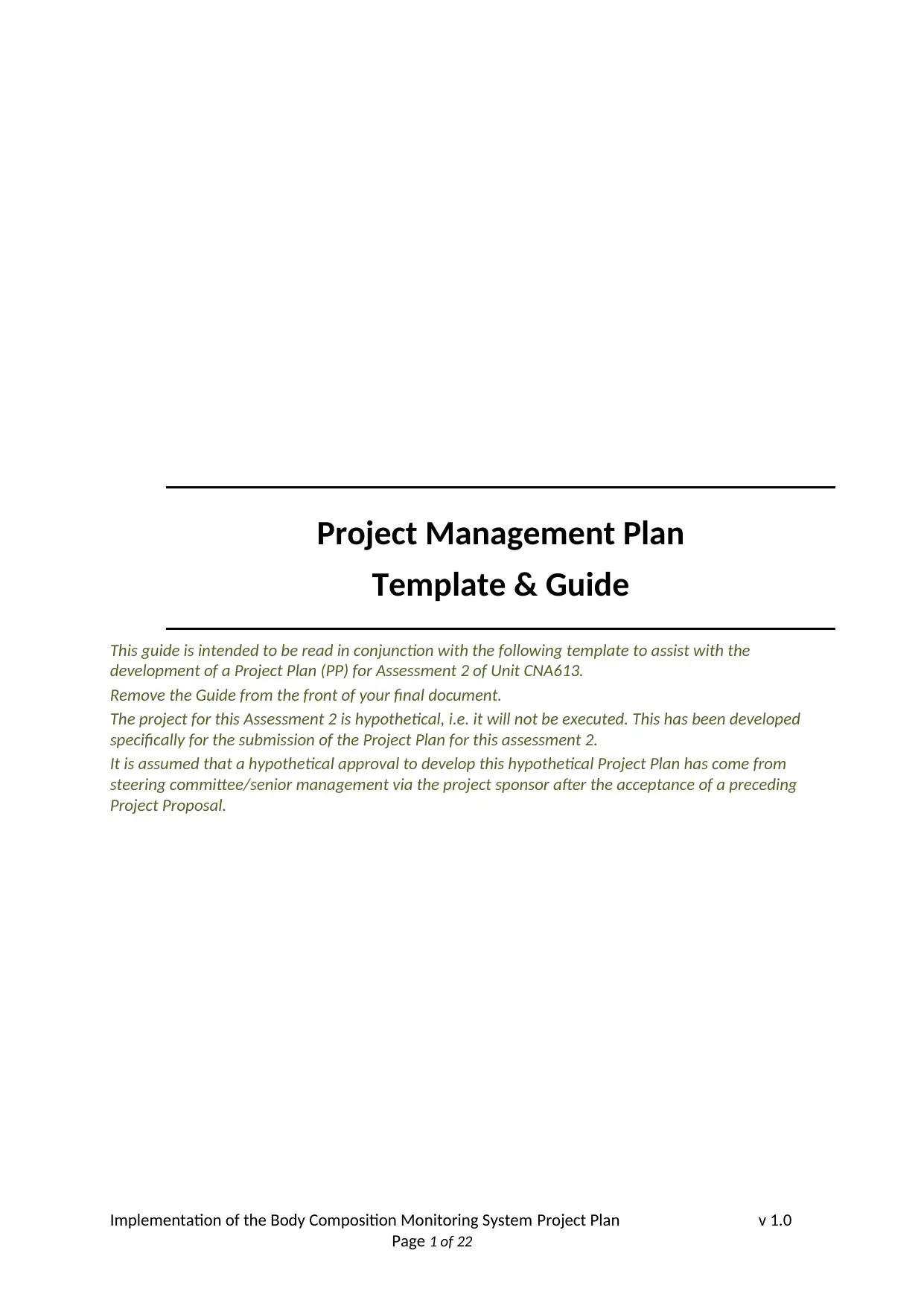
Project Management Plan
Template & Guide
This guide is intended to be read in conjunction with the following template to assist with the
development of a Project Plan (PP) for Assessment 2 of Unit CNA613.
Remove the Guide from the front of your final document.
The project for this Assessment 2 is hypothetical, i.e. it will not be executed. This has been developed
specifically for the submission of the Project Plan for this assessment 2.
It is assumed that a hypothetical approval to develop this hypothetical Project Plan has come from
steering committee/senior management via the project sponsor after the acceptance of a preceding
Project Proposal.
Implementation of the Body Composition Monitoring System Project Plan v 1.0
Page 1 of 22
Template & Guide
This guide is intended to be read in conjunction with the following template to assist with the
development of a Project Plan (PP) for Assessment 2 of Unit CNA613.
Remove the Guide from the front of your final document.
The project for this Assessment 2 is hypothetical, i.e. it will not be executed. This has been developed
specifically for the submission of the Project Plan for this assessment 2.
It is assumed that a hypothetical approval to develop this hypothetical Project Plan has come from
steering committee/senior management via the project sponsor after the acceptance of a preceding
Project Proposal.
Implementation of the Body Composition Monitoring System Project Plan v 1.0
Page 1 of 22
Secure Best Marks with AI Grader
Need help grading? Try our AI Grader for instant feedback on your assignments.
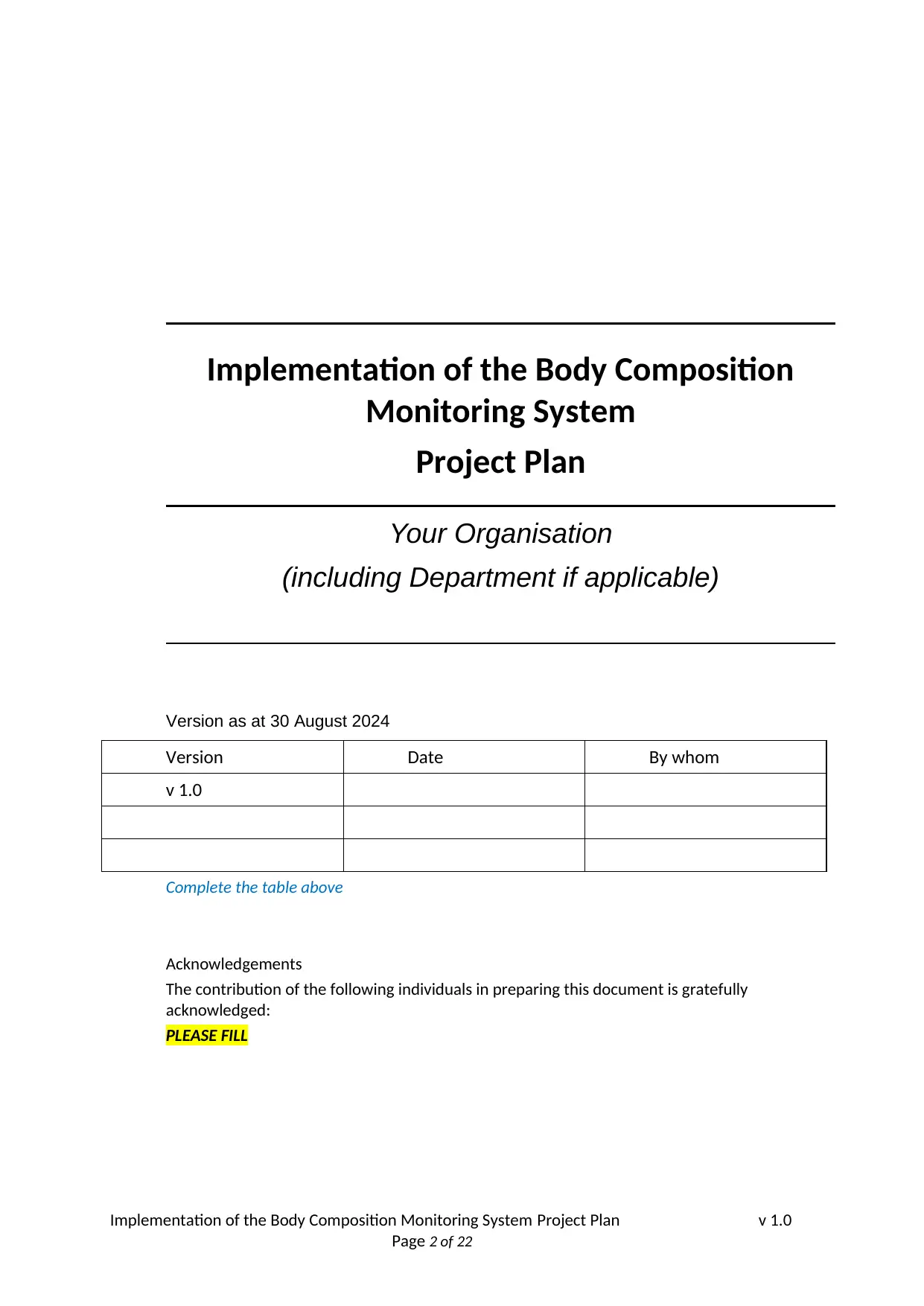
Implementation of the Body Composition
Monitoring System
Project Plan
Your Organisation
(including Department if applicable)
Version as at 30 August 2024
Version Date By whom
v 1.0
Complete the table above
Acknowledgements
The contribution of the following individuals in preparing this document is gratefully
acknowledged:
PLEASE FILL
Implementation of the Body Composition Monitoring System Project Plan v 1.0
Page 2 of 22
Monitoring System
Project Plan
Your Organisation
(including Department if applicable)
Version as at 30 August 2024
Version Date By whom
v 1.0
Complete the table above
Acknowledgements
The contribution of the following individuals in preparing this document is gratefully
acknowledged:
PLEASE FILL
Implementation of the Body Composition Monitoring System Project Plan v 1.0
Page 2 of 22
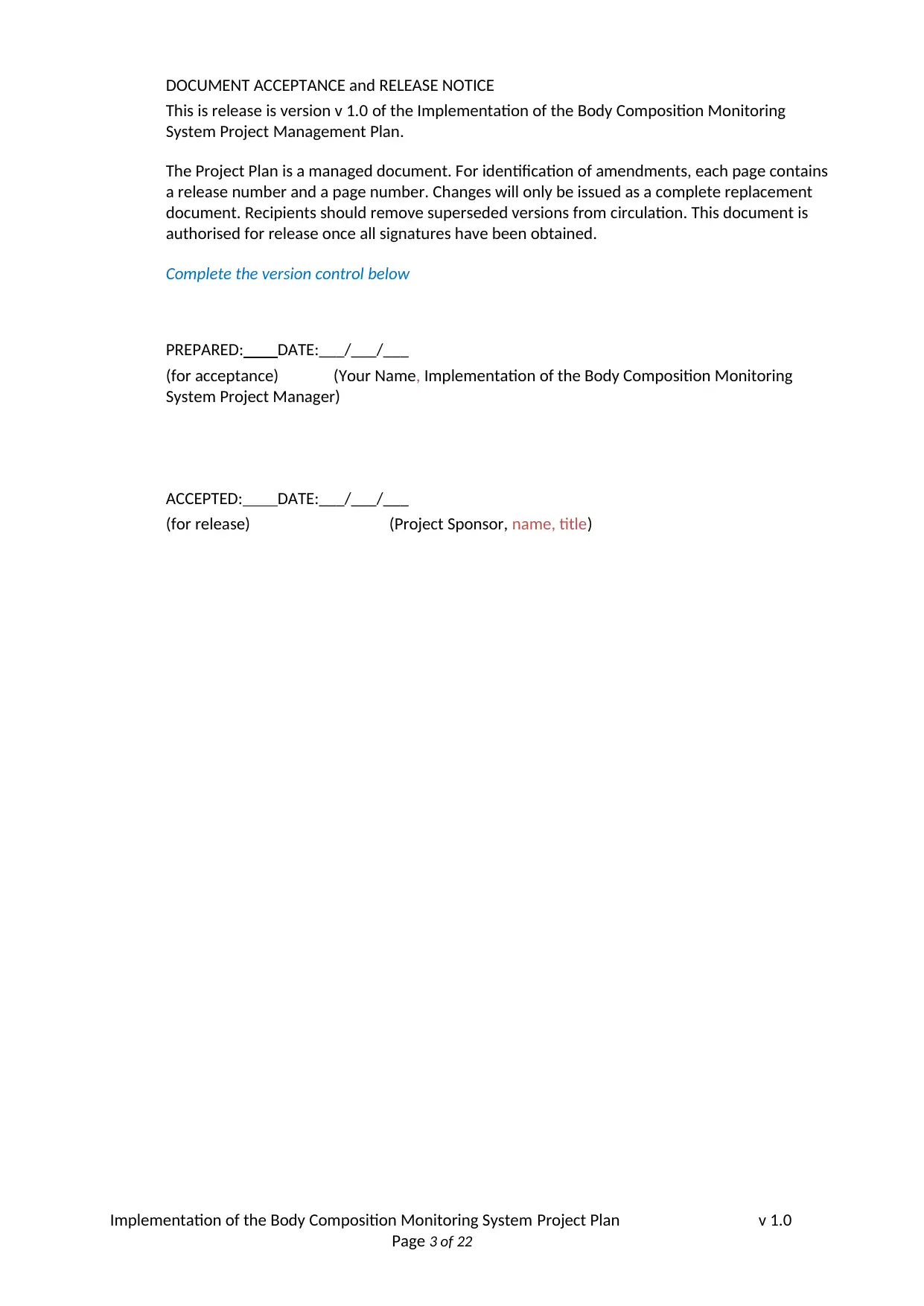
DOCUMENT ACCEPTANCE and RELEASE NOTICE
This is release is version v 1.0 of the Implementation of the Body Composition Monitoring
System Project Management Plan.
The Project Plan is a managed document. For identification of amendments, each page contains
a release number and a page number. Changes will only be issued as a complete replacement
document. Recipients should remove superseded versions from circulation. This document is
authorised for release once all signatures have been obtained.
Complete the version control below
PREPARED: DATE:___/___/___
(for acceptance) (Your Name, Implementation of the Body Composition Monitoring
System Project Manager)
ACCEPTED: DATE:___/___/___
(for release) (Project Sponsor, name, title)
Implementation of the Body Composition Monitoring System Project Plan v 1.0
Page 3 of 22
This is release is version v 1.0 of the Implementation of the Body Composition Monitoring
System Project Management Plan.
The Project Plan is a managed document. For identification of amendments, each page contains
a release number and a page number. Changes will only be issued as a complete replacement
document. Recipients should remove superseded versions from circulation. This document is
authorised for release once all signatures have been obtained.
Complete the version control below
PREPARED: DATE:___/___/___
(for acceptance) (Your Name, Implementation of the Body Composition Monitoring
System Project Manager)
ACCEPTED: DATE:___/___/___
(for release) (Project Sponsor, name, title)
Implementation of the Body Composition Monitoring System Project Plan v 1.0
Page 3 of 22
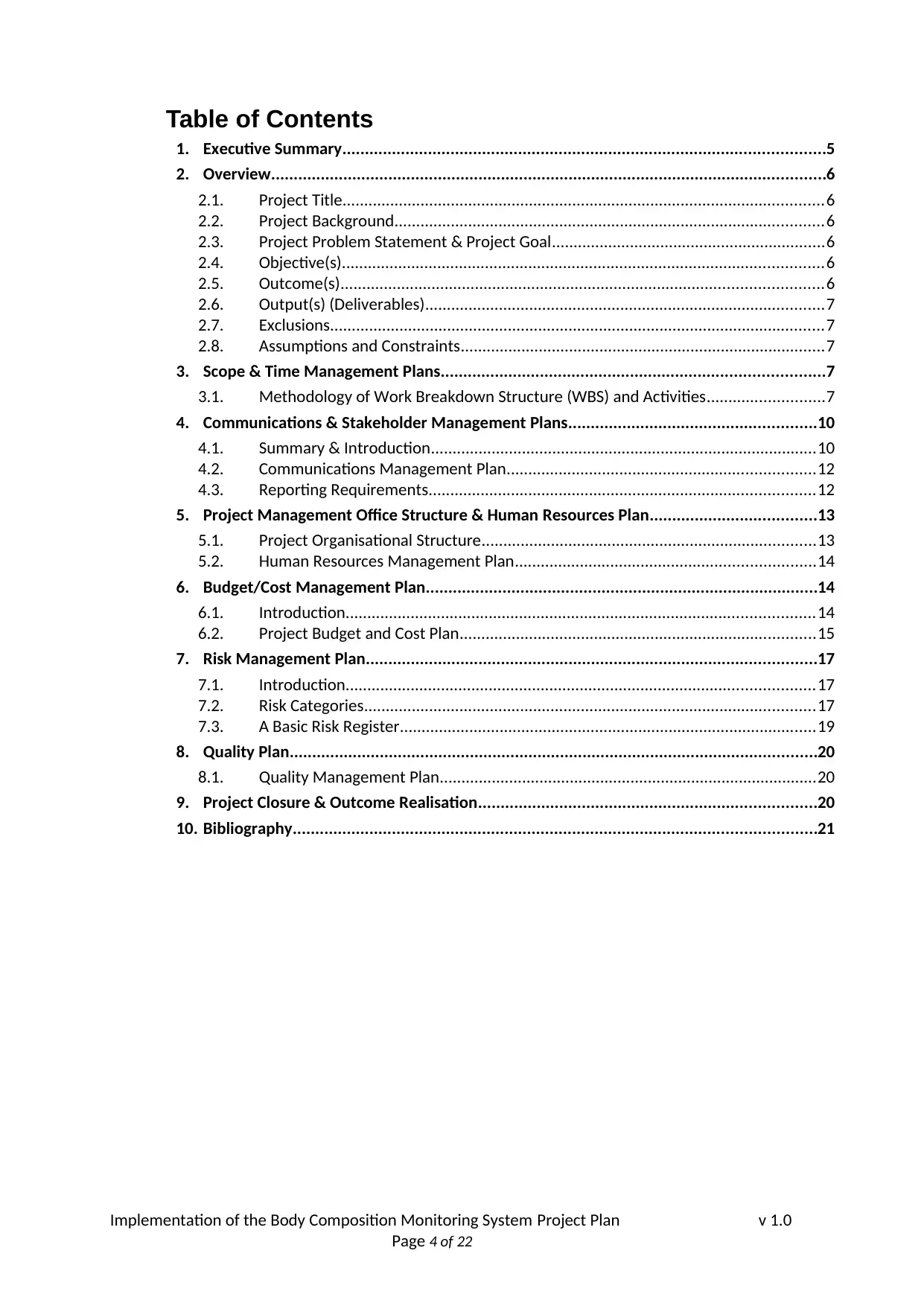
Table of Contents
1. Executive Summary...........................................................................................................5
2. Overview...........................................................................................................................6
2.1. Project Title...............................................................................................................6
2.2. Project Background...................................................................................................6
2.3. Project Problem Statement & Project Goal...............................................................6
2.4. Objective(s)...............................................................................................................6
2.5. Outcome(s)...............................................................................................................6
2.6. Output(s) (Deliverables)............................................................................................7
2.7. Exclusions..................................................................................................................7
2.8. Assumptions and Constraints....................................................................................7
3. Scope & Time Management Plans.....................................................................................7
3.1. Methodology of Work Breakdown Structure (WBS) and Activities...........................7
4. Communications & Stakeholder Management Plans.......................................................10
4.1. Summary & Introduction.........................................................................................10
4.2. Communications Management Plan.......................................................................12
4.3. Reporting Requirements.........................................................................................12
5. Project Management Office Structure & Human Resources Plan.....................................13
5.1. Project Organisational Structure.............................................................................13
5.2. Human Resources Management Plan.....................................................................14
6. Budget/Cost Management Plan.......................................................................................14
6.1. Introduction............................................................................................................14
6.2. Project Budget and Cost Plan..................................................................................15
7. Risk Management Plan....................................................................................................17
7.1. Introduction............................................................................................................17
7.2. Risk Categories........................................................................................................17
7.3. A Basic Risk Register................................................................................................19
8. Quality Plan.....................................................................................................................20
8.1. Quality Management Plan.......................................................................................20
9. Project Closure & Outcome Realisation...........................................................................20
10. Bibliography....................................................................................................................21
Implementation of the Body Composition Monitoring System Project Plan v 1.0
Page 4 of 22
1. Executive Summary...........................................................................................................5
2. Overview...........................................................................................................................6
2.1. Project Title...............................................................................................................6
2.2. Project Background...................................................................................................6
2.3. Project Problem Statement & Project Goal...............................................................6
2.4. Objective(s)...............................................................................................................6
2.5. Outcome(s)...............................................................................................................6
2.6. Output(s) (Deliverables)............................................................................................7
2.7. Exclusions..................................................................................................................7
2.8. Assumptions and Constraints....................................................................................7
3. Scope & Time Management Plans.....................................................................................7
3.1. Methodology of Work Breakdown Structure (WBS) and Activities...........................7
4. Communications & Stakeholder Management Plans.......................................................10
4.1. Summary & Introduction.........................................................................................10
4.2. Communications Management Plan.......................................................................12
4.3. Reporting Requirements.........................................................................................12
5. Project Management Office Structure & Human Resources Plan.....................................13
5.1. Project Organisational Structure.............................................................................13
5.2. Human Resources Management Plan.....................................................................14
6. Budget/Cost Management Plan.......................................................................................14
6.1. Introduction............................................................................................................14
6.2. Project Budget and Cost Plan..................................................................................15
7. Risk Management Plan....................................................................................................17
7.1. Introduction............................................................................................................17
7.2. Risk Categories........................................................................................................17
7.3. A Basic Risk Register................................................................................................19
8. Quality Plan.....................................................................................................................20
8.1. Quality Management Plan.......................................................................................20
9. Project Closure & Outcome Realisation...........................................................................20
10. Bibliography....................................................................................................................21
Implementation of the Body Composition Monitoring System Project Plan v 1.0
Page 4 of 22
Secure Best Marks with AI Grader
Need help grading? Try our AI Grader for instant feedback on your assignments.
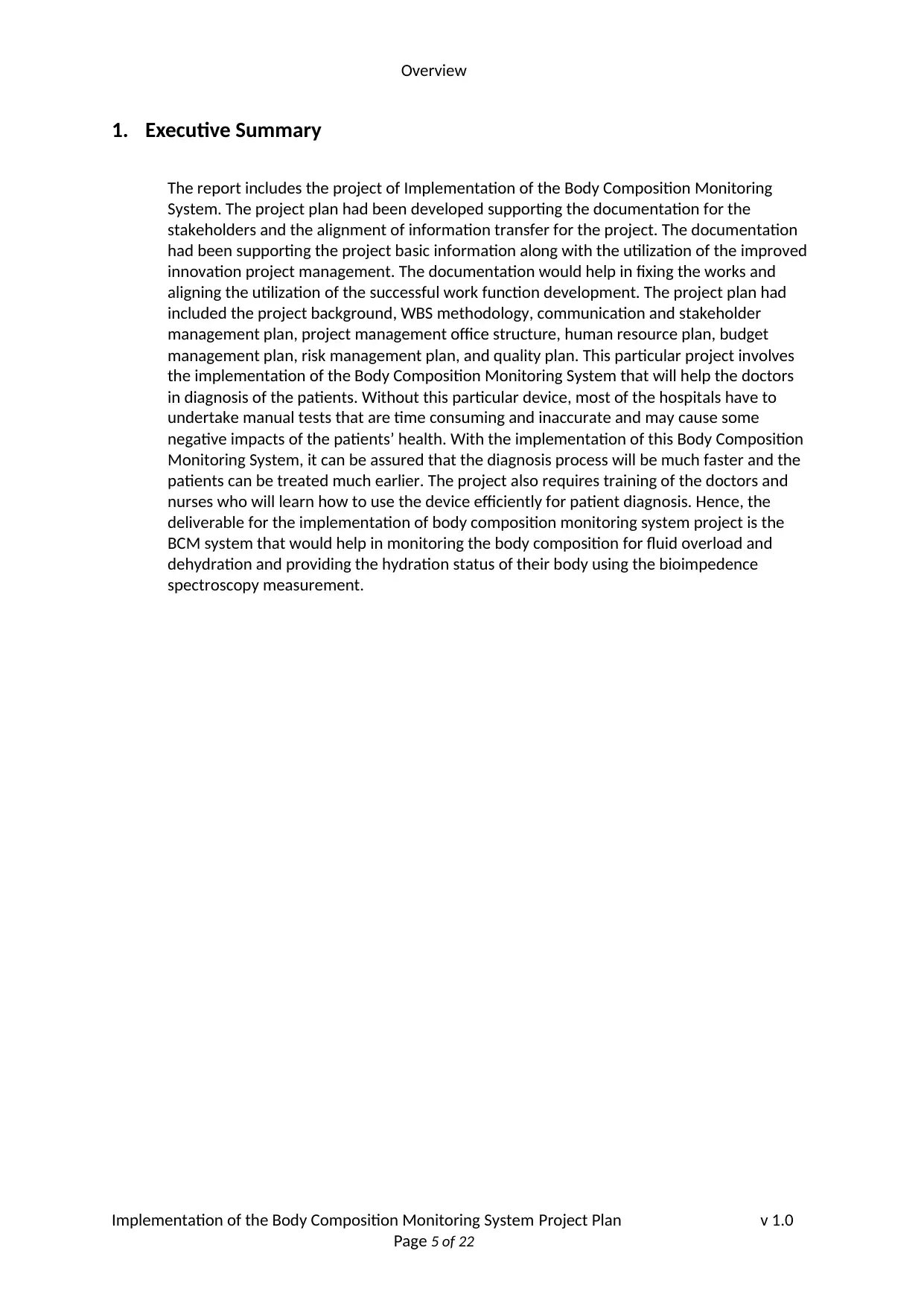
Overview
1. Executive Summary
The report includes the project of Implementation of the Body Composition Monitoring
System. The project plan had been developed supporting the documentation for the
stakeholders and the alignment of information transfer for the project. The documentation
had been supporting the project basic information along with the utilization of the improved
innovation project management. The documentation would help in fixing the works and
aligning the utilization of the successful work function development. The project plan had
included the project background, WBS methodology, communication and stakeholder
management plan, project management office structure, human resource plan, budget
management plan, risk management plan, and quality plan. This particular project involves
the implementation of the Body Composition Monitoring System that will help the doctors
in diagnosis of the patients. Without this particular device, most of the hospitals have to
undertake manual tests that are time consuming and inaccurate and may cause some
negative impacts of the patients’ health. With the implementation of this Body Composition
Monitoring System, it can be assured that the diagnosis process will be much faster and the
patients can be treated much earlier. The project also requires training of the doctors and
nurses who will learn how to use the device efficiently for patient diagnosis. Hence, the
deliverable for the implementation of body composition monitoring system project is the
BCM system that would help in monitoring the body composition for fluid overload and
dehydration and providing the hydration status of their body using the bioimpedence
spectroscopy measurement.
Implementation of the Body Composition Monitoring System Project Plan v 1.0
Page 5 of 22
1. Executive Summary
The report includes the project of Implementation of the Body Composition Monitoring
System. The project plan had been developed supporting the documentation for the
stakeholders and the alignment of information transfer for the project. The documentation
had been supporting the project basic information along with the utilization of the improved
innovation project management. The documentation would help in fixing the works and
aligning the utilization of the successful work function development. The project plan had
included the project background, WBS methodology, communication and stakeholder
management plan, project management office structure, human resource plan, budget
management plan, risk management plan, and quality plan. This particular project involves
the implementation of the Body Composition Monitoring System that will help the doctors
in diagnosis of the patients. Without this particular device, most of the hospitals have to
undertake manual tests that are time consuming and inaccurate and may cause some
negative impacts of the patients’ health. With the implementation of this Body Composition
Monitoring System, it can be assured that the diagnosis process will be much faster and the
patients can be treated much earlier. The project also requires training of the doctors and
nurses who will learn how to use the device efficiently for patient diagnosis. Hence, the
deliverable for the implementation of body composition monitoring system project is the
BCM system that would help in monitoring the body composition for fluid overload and
dehydration and providing the hydration status of their body using the bioimpedence
spectroscopy measurement.
Implementation of the Body Composition Monitoring System Project Plan v 1.0
Page 5 of 22
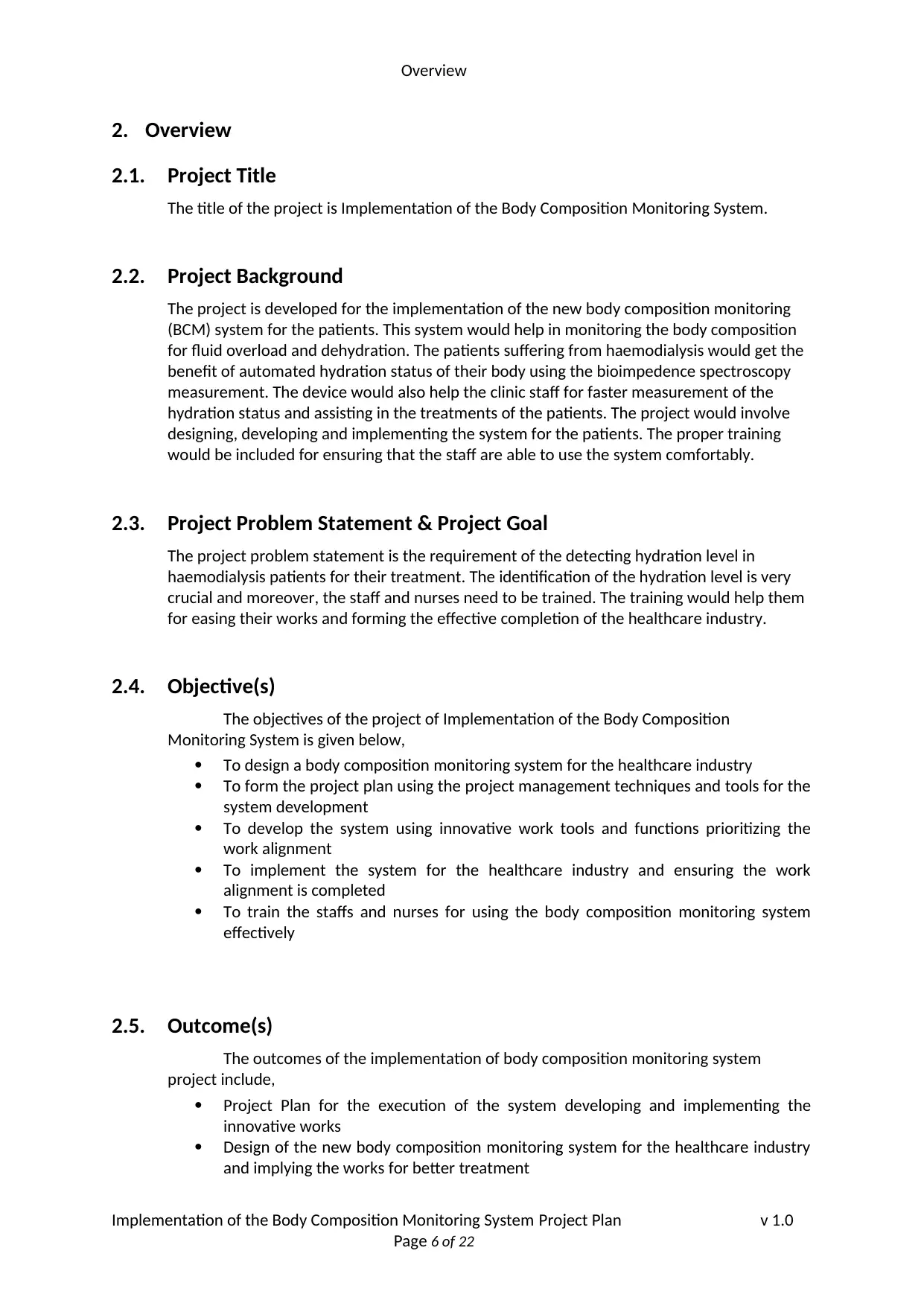
Overview
2. Overview
2.1. Project Title
The title of the project is Implementation of the Body Composition Monitoring System.
2.2. Project Background
The project is developed for the implementation of the new body composition monitoring
(BCM) system for the patients. This system would help in monitoring the body composition
for fluid overload and dehydration. The patients suffering from haemodialysis would get the
benefit of automated hydration status of their body using the bioimpedence spectroscopy
measurement. The device would also help the clinic staff for faster measurement of the
hydration status and assisting in the treatments of the patients. The project would involve
designing, developing and implementing the system for the patients. The proper training
would be included for ensuring that the staff are able to use the system comfortably.
2.3. Project Problem Statement & Project Goal
The project problem statement is the requirement of the detecting hydration level in
haemodialysis patients for their treatment. The identification of the hydration level is very
crucial and moreover, the staff and nurses need to be trained. The training would help them
for easing their works and forming the effective completion of the healthcare industry.
2.4. Objective(s)
The objectives of the project of Implementation of the Body Composition
Monitoring System is given below,
To design a body composition monitoring system for the healthcare industry
To form the project plan using the project management techniques and tools for the
system development
To develop the system using innovative work tools and functions prioritizing the
work alignment
To implement the system for the healthcare industry and ensuring the work
alignment is completed
To train the staffs and nurses for using the body composition monitoring system
effectively
2.5. Outcome(s)
The outcomes of the implementation of body composition monitoring system
project include,
Project Plan for the execution of the system developing and implementing the
innovative works
Design of the new body composition monitoring system for the healthcare industry
and implying the works for better treatment
Implementation of the Body Composition Monitoring System Project Plan v 1.0
Page 6 of 22
2. Overview
2.1. Project Title
The title of the project is Implementation of the Body Composition Monitoring System.
2.2. Project Background
The project is developed for the implementation of the new body composition monitoring
(BCM) system for the patients. This system would help in monitoring the body composition
for fluid overload and dehydration. The patients suffering from haemodialysis would get the
benefit of automated hydration status of their body using the bioimpedence spectroscopy
measurement. The device would also help the clinic staff for faster measurement of the
hydration status and assisting in the treatments of the patients. The project would involve
designing, developing and implementing the system for the patients. The proper training
would be included for ensuring that the staff are able to use the system comfortably.
2.3. Project Problem Statement & Project Goal
The project problem statement is the requirement of the detecting hydration level in
haemodialysis patients for their treatment. The identification of the hydration level is very
crucial and moreover, the staff and nurses need to be trained. The training would help them
for easing their works and forming the effective completion of the healthcare industry.
2.4. Objective(s)
The objectives of the project of Implementation of the Body Composition
Monitoring System is given below,
To design a body composition monitoring system for the healthcare industry
To form the project plan using the project management techniques and tools for the
system development
To develop the system using innovative work tools and functions prioritizing the
work alignment
To implement the system for the healthcare industry and ensuring the work
alignment is completed
To train the staffs and nurses for using the body composition monitoring system
effectively
2.5. Outcome(s)
The outcomes of the implementation of body composition monitoring system
project include,
Project Plan for the execution of the system developing and implementing the
innovative works
Design of the new body composition monitoring system for the healthcare industry
and implying the works for better treatment
Implementation of the Body Composition Monitoring System Project Plan v 1.0
Page 6 of 22
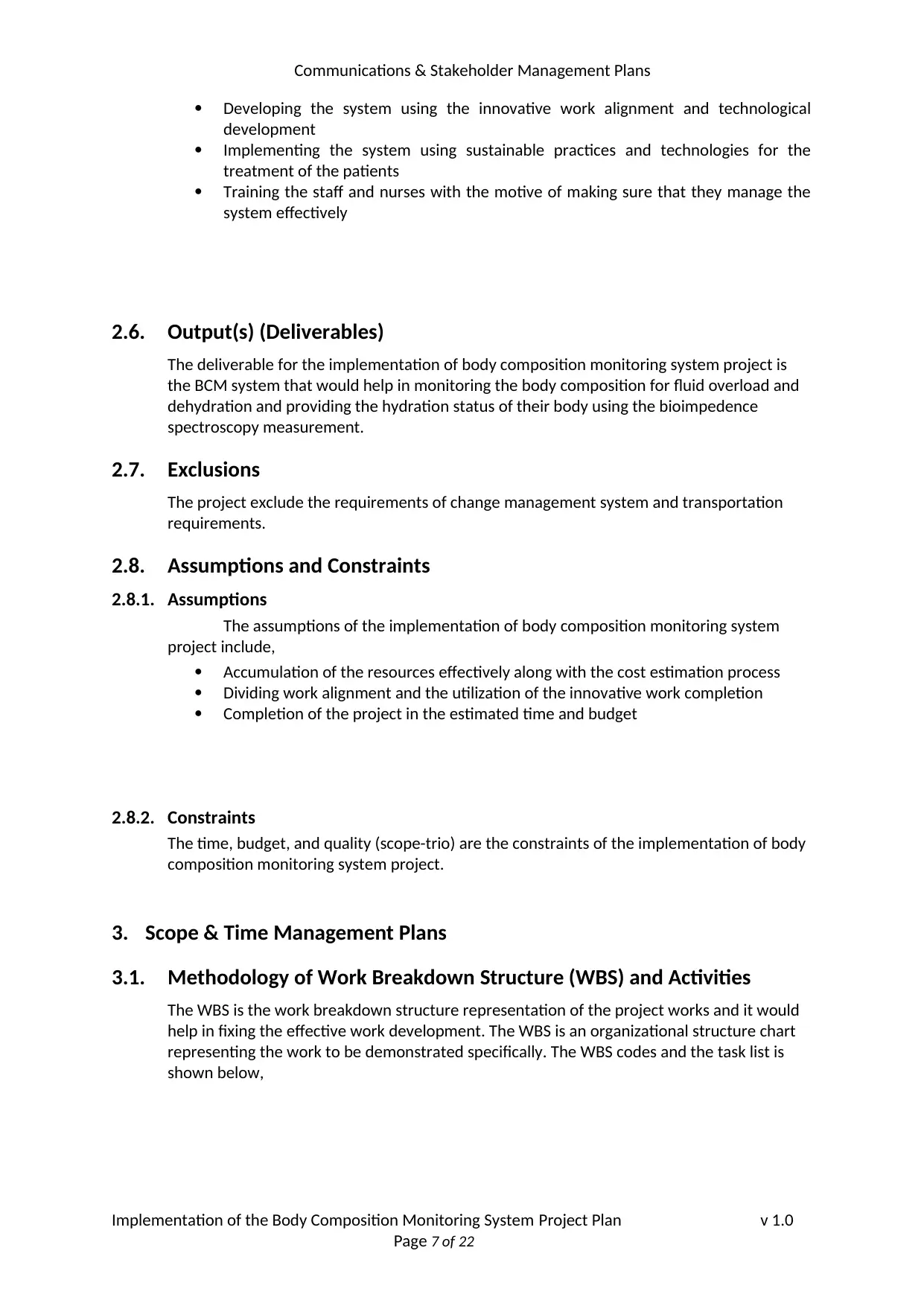
Communications & Stakeholder Management Plans
Developing the system using the innovative work alignment and technological
development
Implementing the system using sustainable practices and technologies for the
treatment of the patients
Training the staff and nurses with the motive of making sure that they manage the
system effectively
2.6. Output(s) (Deliverables)
The deliverable for the implementation of body composition monitoring system project is
the BCM system that would help in monitoring the body composition for fluid overload and
dehydration and providing the hydration status of their body using the bioimpedence
spectroscopy measurement.
2.7. Exclusions
The project exclude the requirements of change management system and transportation
requirements.
2.8. Assumptions and Constraints
2.8.1. Assumptions
The assumptions of the implementation of body composition monitoring system
project include,
Accumulation of the resources effectively along with the cost estimation process
Dividing work alignment and the utilization of the innovative work completion
Completion of the project in the estimated time and budget
2.8.2. Constraints
The time, budget, and quality (scope-trio) are the constraints of the implementation of body
composition monitoring system project.
3. Scope & Time Management Plans
3.1. Methodology of Work Breakdown Structure (WBS) and Activities
The WBS is the work breakdown structure representation of the project works and it would
help in fixing the effective work development. The WBS is an organizational structure chart
representing the work to be demonstrated specifically. The WBS codes and the task list is
shown below,
Implementation of the Body Composition Monitoring System Project Plan v 1.0
Page 7 of 22
Developing the system using the innovative work alignment and technological
development
Implementing the system using sustainable practices and technologies for the
treatment of the patients
Training the staff and nurses with the motive of making sure that they manage the
system effectively
2.6. Output(s) (Deliverables)
The deliverable for the implementation of body composition monitoring system project is
the BCM system that would help in monitoring the body composition for fluid overload and
dehydration and providing the hydration status of their body using the bioimpedence
spectroscopy measurement.
2.7. Exclusions
The project exclude the requirements of change management system and transportation
requirements.
2.8. Assumptions and Constraints
2.8.1. Assumptions
The assumptions of the implementation of body composition monitoring system
project include,
Accumulation of the resources effectively along with the cost estimation process
Dividing work alignment and the utilization of the innovative work completion
Completion of the project in the estimated time and budget
2.8.2. Constraints
The time, budget, and quality (scope-trio) are the constraints of the implementation of body
composition monitoring system project.
3. Scope & Time Management Plans
3.1. Methodology of Work Breakdown Structure (WBS) and Activities
The WBS is the work breakdown structure representation of the project works and it would
help in fixing the effective work development. The WBS is an organizational structure chart
representing the work to be demonstrated specifically. The WBS codes and the task list is
shown below,
Implementation of the Body Composition Monitoring System Project Plan v 1.0
Page 7 of 22
Paraphrase This Document
Need a fresh take? Get an instant paraphrase of this document with our AI Paraphraser
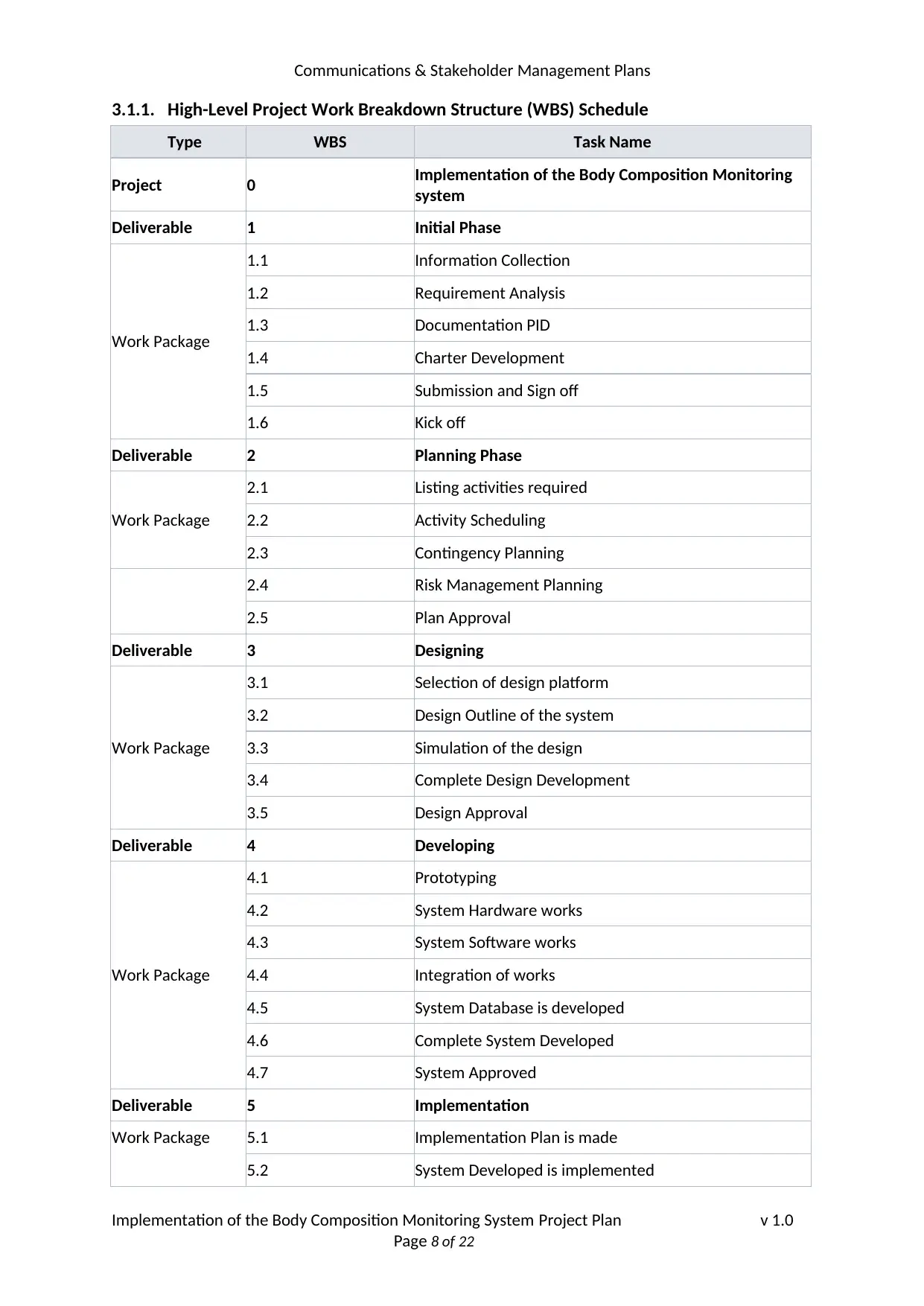
Communications & Stakeholder Management Plans
3.1.1. High-Level Project Work Breakdown Structure (WBS) Schedule
Type WBS Task Name
Project 0 Implementation of the Body Composition Monitoring
system
Deliverable 1 Initial Phase
Work Package
1.1 Information Collection
1.2 Requirement Analysis
1.3 Documentation PID
1.4 Charter Development
1.5 Submission and Sign off
1.6 Kick off
Deliverable 2 Planning Phase
Work Package
2.1 Listing activities required
2.2 Activity Scheduling
2.3 Contingency Planning
2.4 Risk Management Planning
2.5 Plan Approval
Deliverable 3 Designing
Work Package
3.1 Selection of design platform
3.2 Design Outline of the system
3.3 Simulation of the design
3.4 Complete Design Development
3.5 Design Approval
Deliverable 4 Developing
Work Package
4.1 Prototyping
4.2 System Hardware works
4.3 System Software works
4.4 Integration of works
4.5 System Database is developed
4.6 Complete System Developed
4.7 System Approved
Deliverable 5 Implementation
Work Package 5.1 Implementation Plan is made
5.2 System Developed is implemented
Implementation of the Body Composition Monitoring System Project Plan v 1.0
Page 8 of 22
3.1.1. High-Level Project Work Breakdown Structure (WBS) Schedule
Type WBS Task Name
Project 0 Implementation of the Body Composition Monitoring
system
Deliverable 1 Initial Phase
Work Package
1.1 Information Collection
1.2 Requirement Analysis
1.3 Documentation PID
1.4 Charter Development
1.5 Submission and Sign off
1.6 Kick off
Deliverable 2 Planning Phase
Work Package
2.1 Listing activities required
2.2 Activity Scheduling
2.3 Contingency Planning
2.4 Risk Management Planning
2.5 Plan Approval
Deliverable 3 Designing
Work Package
3.1 Selection of design platform
3.2 Design Outline of the system
3.3 Simulation of the design
3.4 Complete Design Development
3.5 Design Approval
Deliverable 4 Developing
Work Package
4.1 Prototyping
4.2 System Hardware works
4.3 System Software works
4.4 Integration of works
4.5 System Database is developed
4.6 Complete System Developed
4.7 System Approved
Deliverable 5 Implementation
Work Package 5.1 Implementation Plan is made
5.2 System Developed is implemented
Implementation of the Body Composition Monitoring System Project Plan v 1.0
Page 8 of 22

Communications & Stakeholder Management Plans
5.3 Contingency Plan Applied
5.4 Monitoring Process is used
5.5 System Implemented
5.6 Project Closed
3.1.2. High-Level Milestones Schedule
WBS Task Name Finish
1.6 Kick off Fri 18-01-19
2.5 Plan Approval Tue 05-02-19
3.5 Design Approval Thu 21-02-19
4.7 System Approved Thu 28-03-19
5.6 Project Closed Fri 19-04-19
Implementation of the Body Composition Monitoring System Project Plan v 1.0
Page 9 of 22
5.3 Contingency Plan Applied
5.4 Monitoring Process is used
5.5 System Implemented
5.6 Project Closed
3.1.2. High-Level Milestones Schedule
WBS Task Name Finish
1.6 Kick off Fri 18-01-19
2.5 Plan Approval Tue 05-02-19
3.5 Design Approval Thu 21-02-19
4.7 System Approved Thu 28-03-19
5.6 Project Closed Fri 19-04-19
Implementation of the Body Composition Monitoring System Project Plan v 1.0
Page 9 of 22
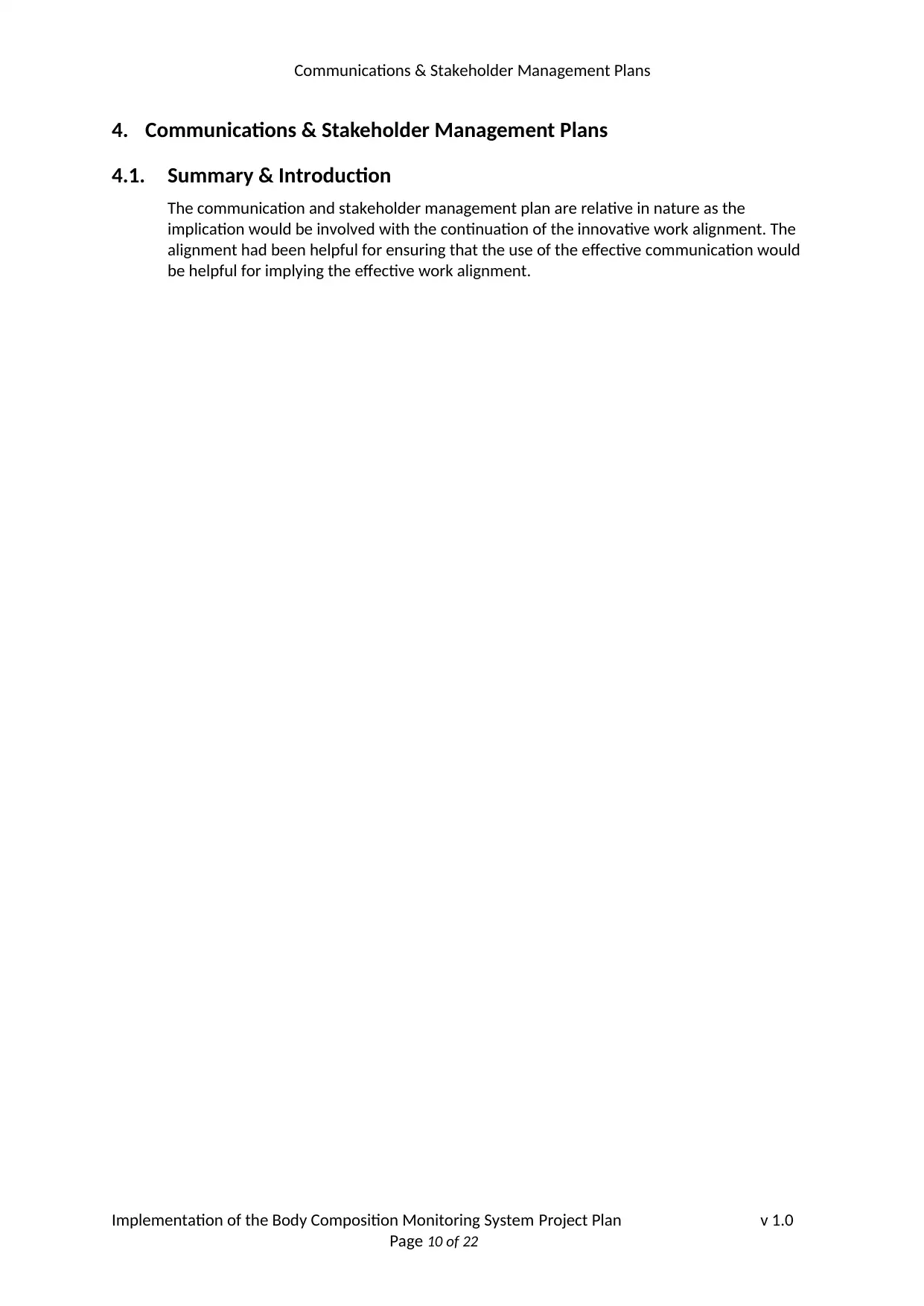
Communications & Stakeholder Management Plans
4. Communications & Stakeholder Management Plans
4.1. Summary & Introduction
The communication and stakeholder management plan are relative in nature as the
implication would be involved with the continuation of the innovative work alignment. The
alignment had been helpful for ensuring that the use of the effective communication would
be helpful for implying the effective work alignment.
Implementation of the Body Composition Monitoring System Project Plan v 1.0
Page 10 of 22
4. Communications & Stakeholder Management Plans
4.1. Summary & Introduction
The communication and stakeholder management plan are relative in nature as the
implication would be involved with the continuation of the innovative work alignment. The
alignment had been helpful for ensuring that the use of the effective communication would
be helpful for implying the effective work alignment.
Implementation of the Body Composition Monitoring System Project Plan v 1.0
Page 10 of 22
Secure Best Marks with AI Grader
Need help grading? Try our AI Grader for instant feedback on your assignments.
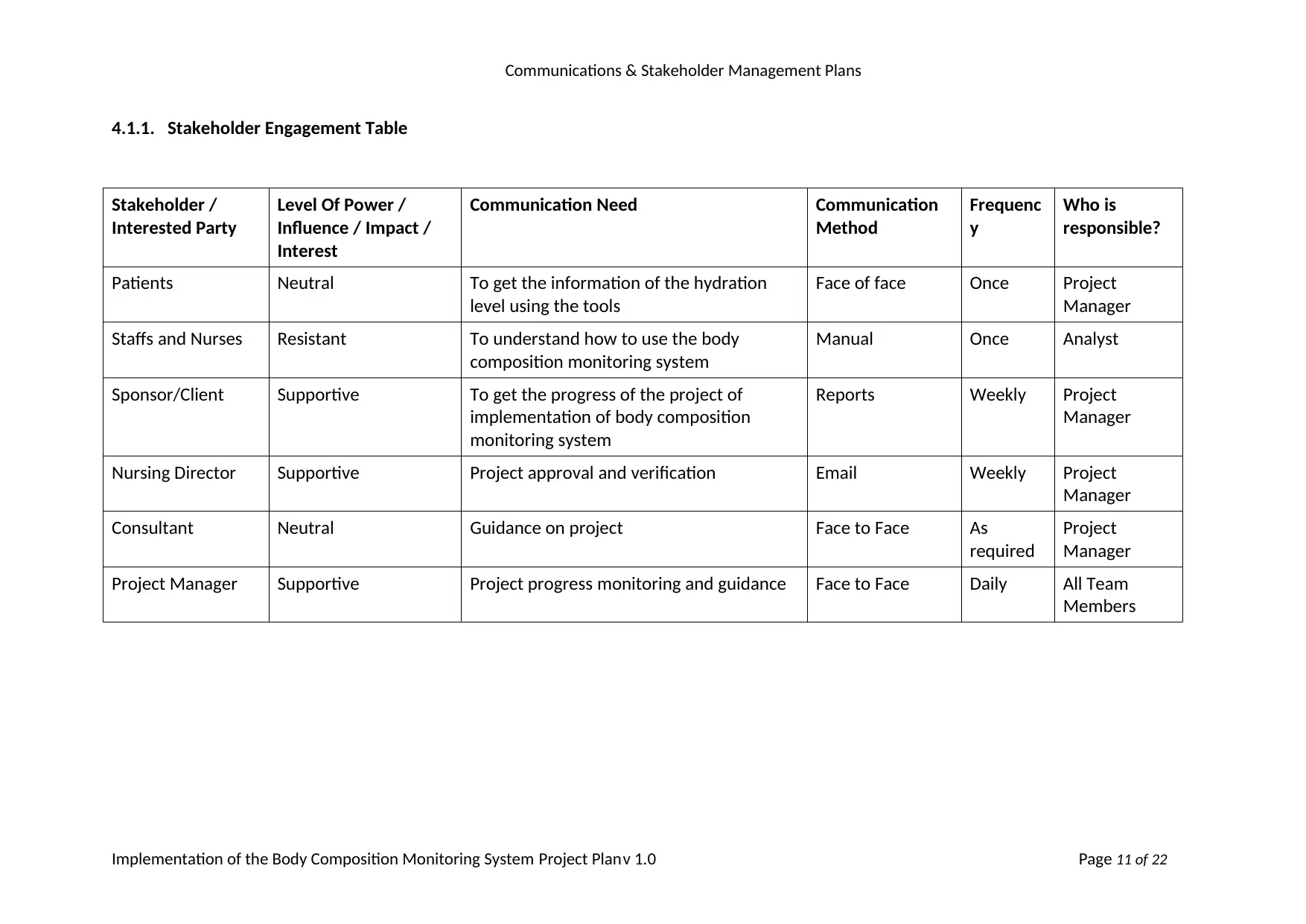
Communications & Stakeholder Management Plans
4.1.1. Stakeholder Engagement Table
Stakeholder /
Interested Party
Level Of Power /
Influence / Impact /
Interest
Communication Need Communication
Method
Frequenc
y
Who is
responsible?
Patients Neutral To get the information of the hydration
level using the tools
Face of face Once Project
Manager
Staffs and Nurses Resistant To understand how to use the body
composition monitoring system
Manual Once Analyst
Sponsor/Client Supportive To get the progress of the project of
implementation of body composition
monitoring system
Reports Weekly Project
Manager
Nursing Director Supportive Project approval and verification Email Weekly Project
Manager
Consultant Neutral Guidance on project Face to Face As
required
Project
Manager
Project Manager Supportive Project progress monitoring and guidance Face to Face Daily All Team
Members
Implementation of the Body Composition Monitoring System Project Planv 1.0 Page 11 of 22
4.1.1. Stakeholder Engagement Table
Stakeholder /
Interested Party
Level Of Power /
Influence / Impact /
Interest
Communication Need Communication
Method
Frequenc
y
Who is
responsible?
Patients Neutral To get the information of the hydration
level using the tools
Face of face Once Project
Manager
Staffs and Nurses Resistant To understand how to use the body
composition monitoring system
Manual Once Analyst
Sponsor/Client Supportive To get the progress of the project of
implementation of body composition
monitoring system
Reports Weekly Project
Manager
Nursing Director Supportive Project approval and verification Email Weekly Project
Manager
Consultant Neutral Guidance on project Face to Face As
required
Project
Manager
Project Manager Supportive Project progress monitoring and guidance Face to Face Daily All Team
Members
Implementation of the Body Composition Monitoring System Project Planv 1.0 Page 11 of 22
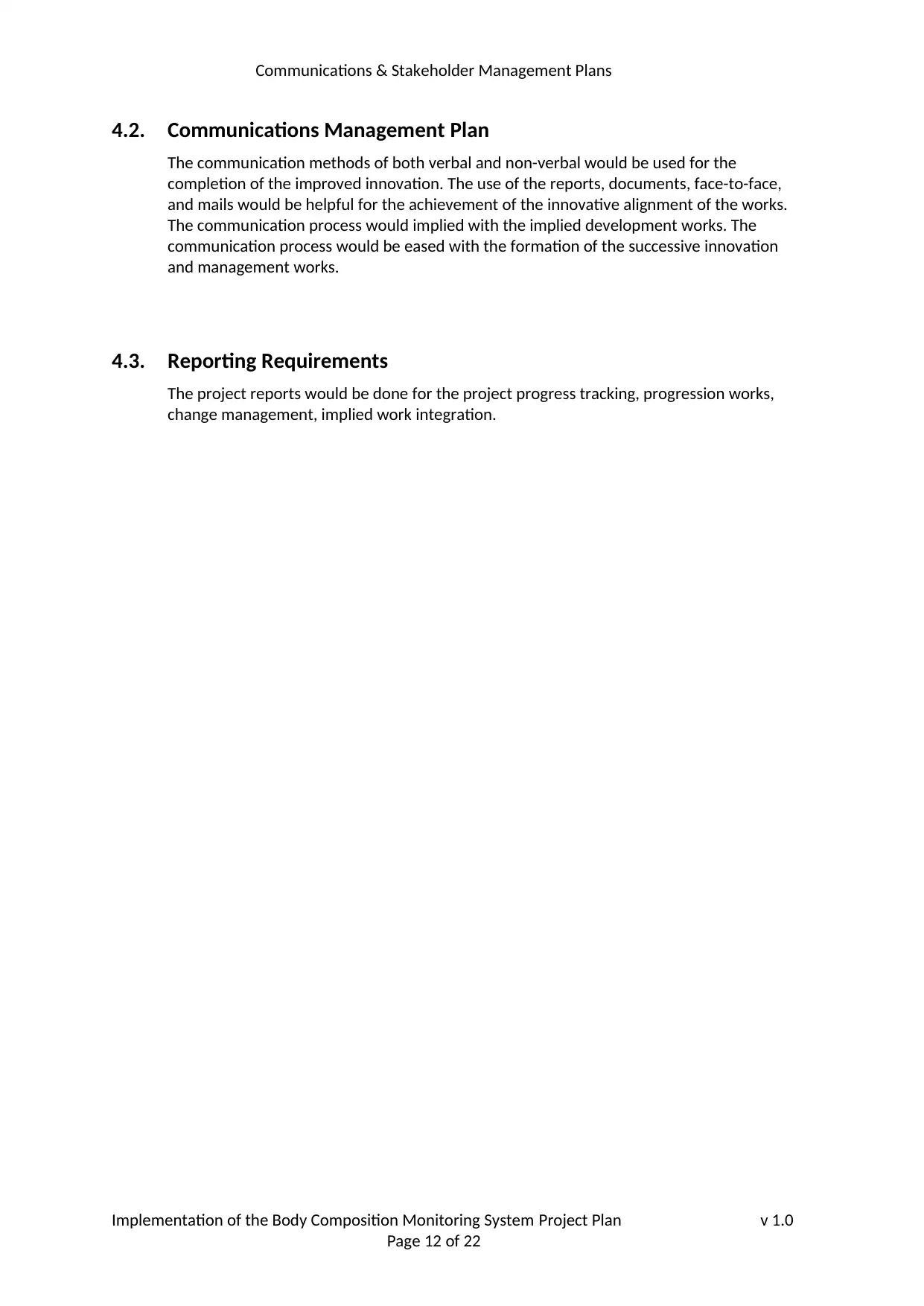
Communications & Stakeholder Management Plans
4.2. Communications Management Plan
The communication methods of both verbal and non-verbal would be used for the
completion of the improved innovation. The use of the reports, documents, face-to-face,
and mails would be helpful for the achievement of the innovative alignment of the works.
The communication process would implied with the implied development works. The
communication process would be eased with the formation of the successive innovation
and management works.
4.3. Reporting Requirements
The project reports would be done for the project progress tracking, progression works,
change management, implied work integration.
Implementation of the Body Composition Monitoring System Project Plan v 1.0
Page 12 of 22
4.2. Communications Management Plan
The communication methods of both verbal and non-verbal would be used for the
completion of the improved innovation. The use of the reports, documents, face-to-face,
and mails would be helpful for the achievement of the innovative alignment of the works.
The communication process would implied with the implied development works. The
communication process would be eased with the formation of the successive innovation
and management works.
4.3. Reporting Requirements
The project reports would be done for the project progress tracking, progression works,
change management, implied work integration.
Implementation of the Body Composition Monitoring System Project Plan v 1.0
Page 12 of 22
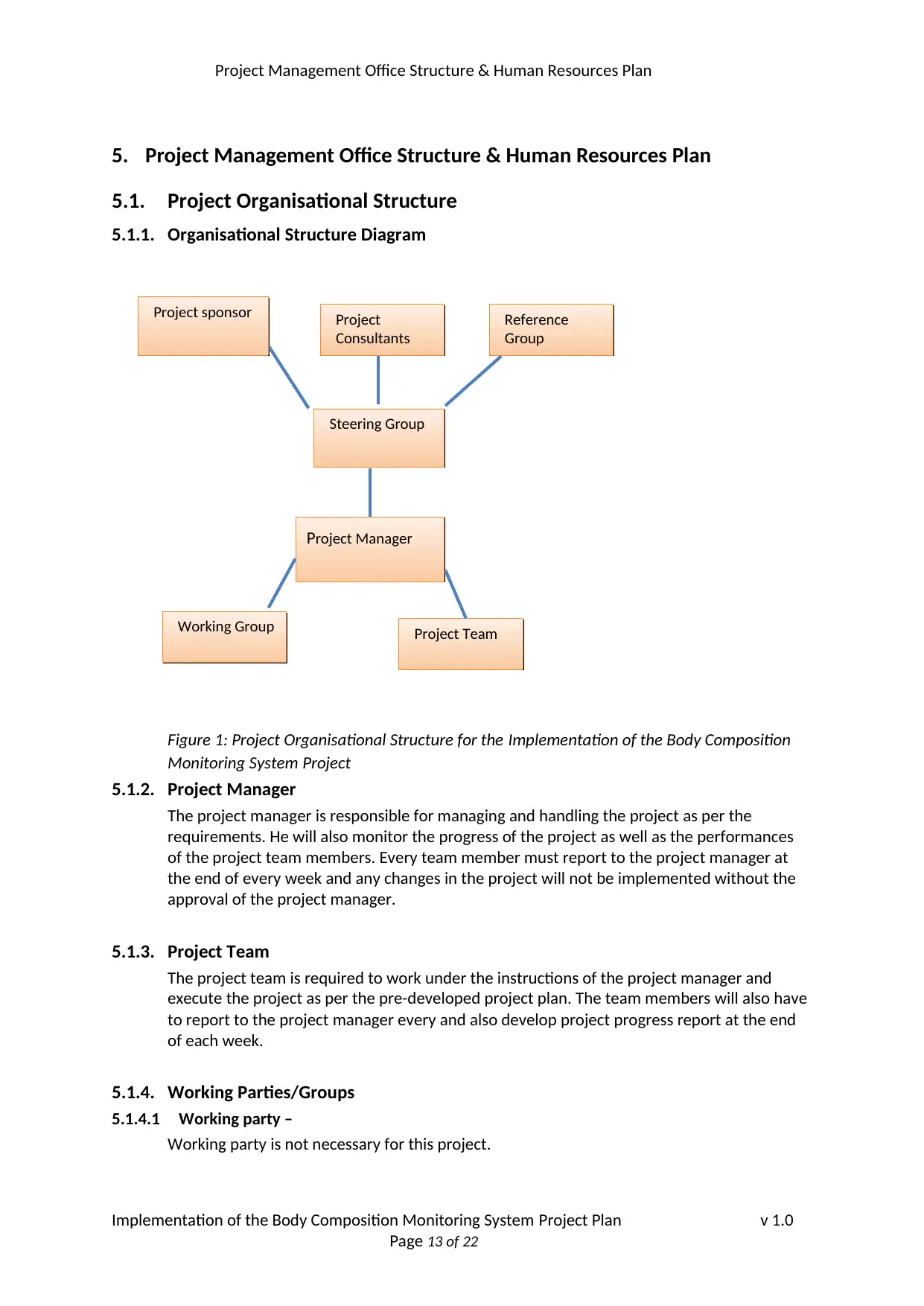
Project Management Office Structure & Human Resources Plan
5. Project Management Office Structure & Human Resources Plan
5.1. Project Organisational Structure
5.1.1. Organisational Structure Diagram
Figure 1: Project Organisational Structure for the Implementation of the Body Composition
Monitoring System Project
5.1.2. Project Manager
The project manager is responsible for managing and handling the project as per the
requirements. He will also monitor the progress of the project as well as the performances
of the project team members. Every team member must report to the project manager at
the end of every week and any changes in the project will not be implemented without the
approval of the project manager.
5.1.3. Project Team
The project team is required to work under the instructions of the project manager and
execute the project as per the pre-developed project plan. The team members will also have
to report to the project manager every and also develop project progress report at the end
of each week.
5.1.4. Working Parties/Groups
5.1.4.1 Working party –
Working party is not necessary for this project.
Implementation of the Body Composition Monitoring System Project Plan v 1.0
Page 13 of 22
Project sponsor
Project Team
Reference
Group
Project Manager
Working Group
Steering Group
Project
Consultants
5. Project Management Office Structure & Human Resources Plan
5.1. Project Organisational Structure
5.1.1. Organisational Structure Diagram
Figure 1: Project Organisational Structure for the Implementation of the Body Composition
Monitoring System Project
5.1.2. Project Manager
The project manager is responsible for managing and handling the project as per the
requirements. He will also monitor the progress of the project as well as the performances
of the project team members. Every team member must report to the project manager at
the end of every week and any changes in the project will not be implemented without the
approval of the project manager.
5.1.3. Project Team
The project team is required to work under the instructions of the project manager and
execute the project as per the pre-developed project plan. The team members will also have
to report to the project manager every and also develop project progress report at the end
of each week.
5.1.4. Working Parties/Groups
5.1.4.1 Working party –
Working party is not necessary for this project.
Implementation of the Body Composition Monitoring System Project Plan v 1.0
Page 13 of 22
Project sponsor
Project Team
Reference
Group
Project Manager
Working Group
Steering Group
Project
Consultants
Paraphrase This Document
Need a fresh take? Get an instant paraphrase of this document with our AI Paraphraser
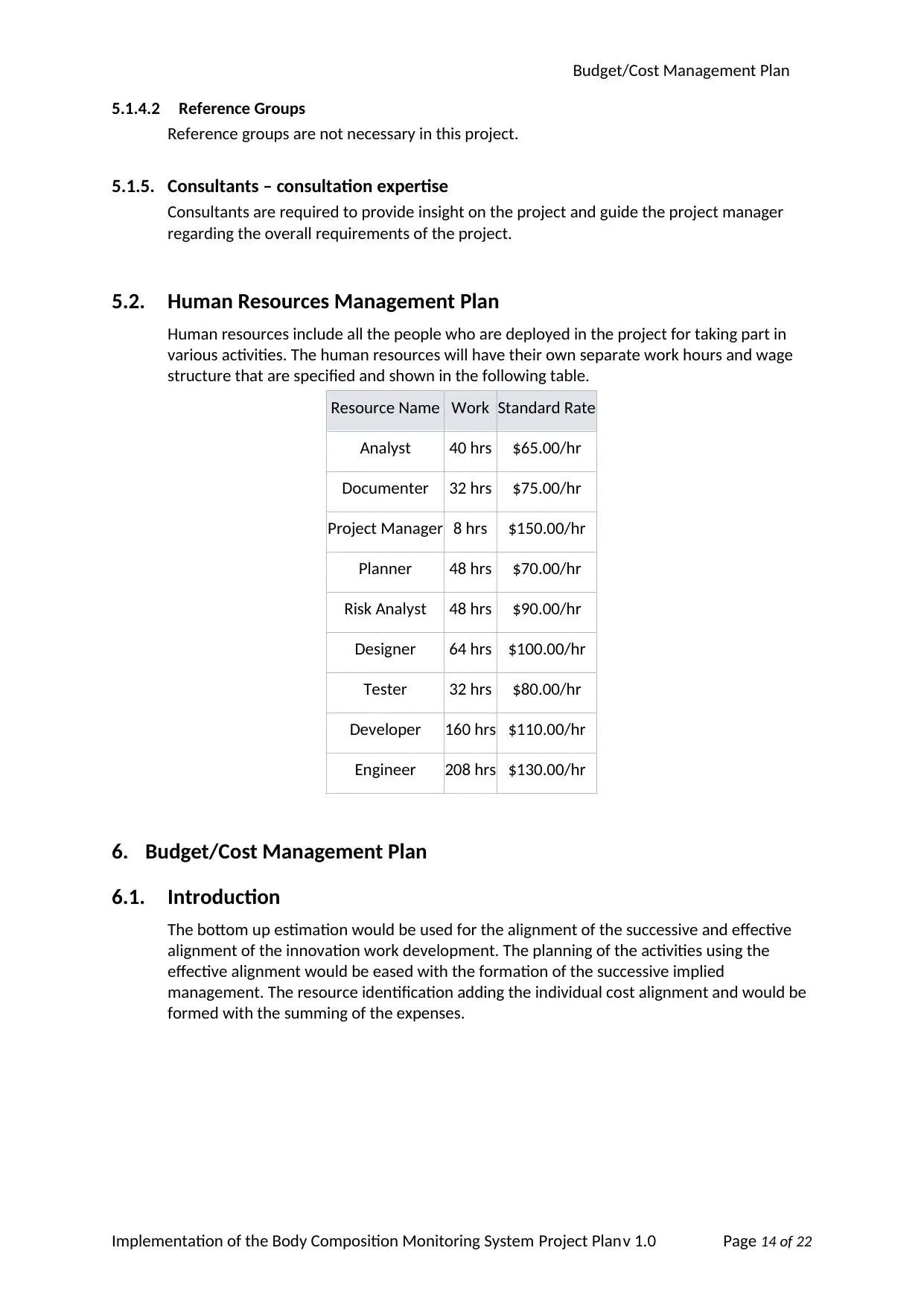
Budget/Cost Management Plan
5.1.4.2 Reference Groups
Reference groups are not necessary in this project.
5.1.5. Consultants – consultation expertise
Consultants are required to provide insight on the project and guide the project manager
regarding the overall requirements of the project.
5.2. Human Resources Management Plan
Human resources include all the people who are deployed in the project for taking part in
various activities. The human resources will have their own separate work hours and wage
structure that are specified and shown in the following table.
Resource Name Work Standard Rate
Analyst 40 hrs $65.00/hr
Documenter 32 hrs $75.00/hr
Project Manager 8 hrs $150.00/hr
Planner 48 hrs $70.00/hr
Risk Analyst 48 hrs $90.00/hr
Designer 64 hrs $100.00/hr
Tester 32 hrs $80.00/hr
Developer 160 hrs $110.00/hr
Engineer 208 hrs $130.00/hr
6. Budget/Cost Management Plan
6.1. Introduction
The bottom up estimation would be used for the alignment of the successive and effective
alignment of the innovation work development. The planning of the activities using the
effective alignment would be eased with the formation of the successive implied
management. The resource identification adding the individual cost alignment and would be
formed with the summing of the expenses.
Implementation of the Body Composition Monitoring System Project Planv 1.0 Page 14 of 22
5.1.4.2 Reference Groups
Reference groups are not necessary in this project.
5.1.5. Consultants – consultation expertise
Consultants are required to provide insight on the project and guide the project manager
regarding the overall requirements of the project.
5.2. Human Resources Management Plan
Human resources include all the people who are deployed in the project for taking part in
various activities. The human resources will have their own separate work hours and wage
structure that are specified and shown in the following table.
Resource Name Work Standard Rate
Analyst 40 hrs $65.00/hr
Documenter 32 hrs $75.00/hr
Project Manager 8 hrs $150.00/hr
Planner 48 hrs $70.00/hr
Risk Analyst 48 hrs $90.00/hr
Designer 64 hrs $100.00/hr
Tester 32 hrs $80.00/hr
Developer 160 hrs $110.00/hr
Engineer 208 hrs $130.00/hr
6. Budget/Cost Management Plan
6.1. Introduction
The bottom up estimation would be used for the alignment of the successive and effective
alignment of the innovation work development. The planning of the activities using the
effective alignment would be eased with the formation of the successive implied
management. The resource identification adding the individual cost alignment and would be
formed with the summing of the expenses.
Implementation of the Body Composition Monitoring System Project Planv 1.0 Page 14 of 22
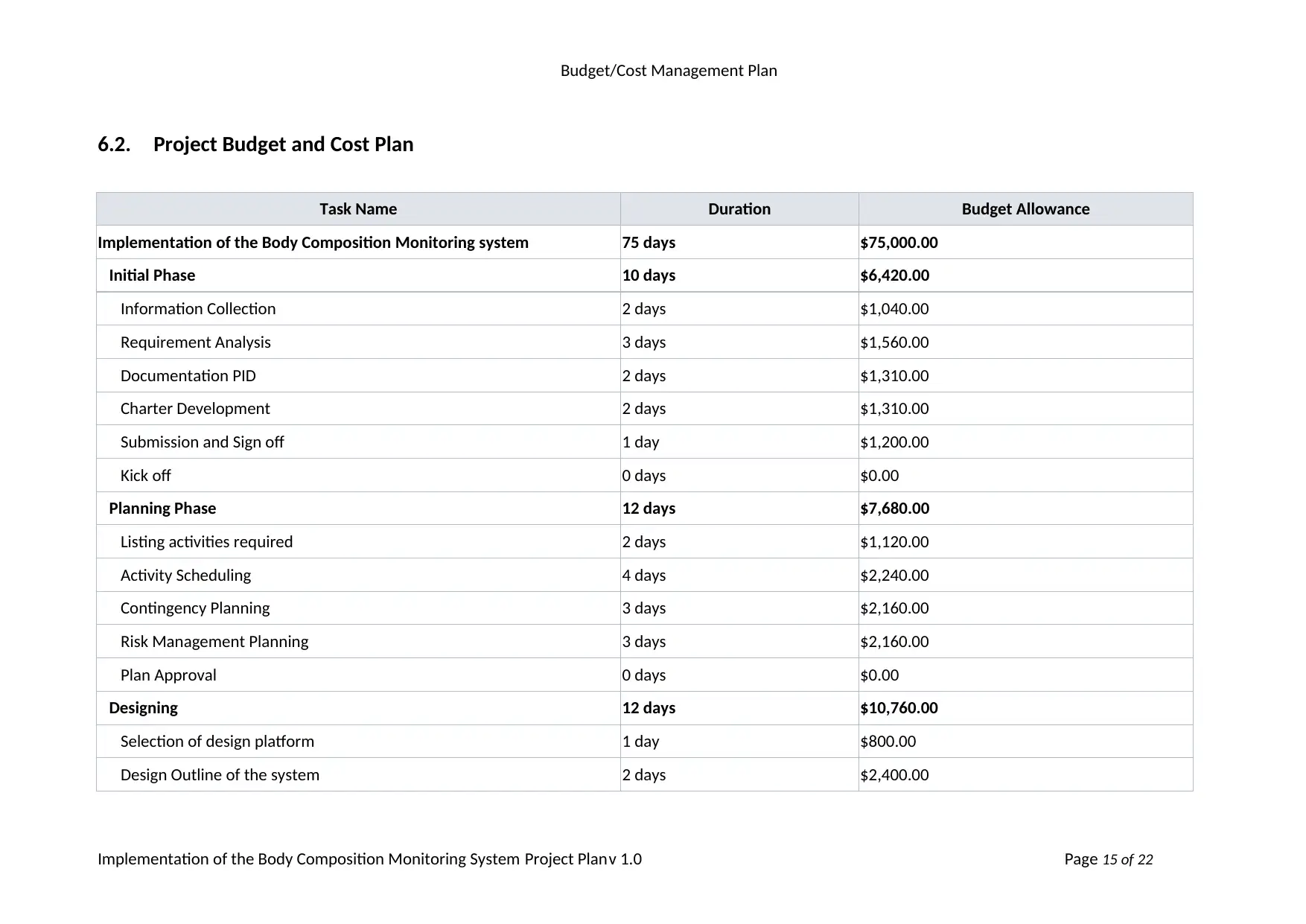
Budget/Cost Management Plan
6.2. Project Budget and Cost Plan
Task Name Duration Budget Allowance
Implementation of the Body Composition Monitoring system 75 days $75,000.00
Initial Phase 10 days $6,420.00
Information Collection 2 days $1,040.00
Requirement Analysis 3 days $1,560.00
Documentation PID 2 days $1,310.00
Charter Development 2 days $1,310.00
Submission and Sign off 1 day $1,200.00
Kick off 0 days $0.00
Planning Phase 12 days $7,680.00
Listing activities required 2 days $1,120.00
Activity Scheduling 4 days $2,240.00
Contingency Planning 3 days $2,160.00
Risk Management Planning 3 days $2,160.00
Plan Approval 0 days $0.00
Designing 12 days $10,760.00
Selection of design platform 1 day $800.00
Design Outline of the system 2 days $2,400.00
Implementation of the Body Composition Monitoring System Project Planv 1.0 Page 15 of 22
6.2. Project Budget and Cost Plan
Task Name Duration Budget Allowance
Implementation of the Body Composition Monitoring system 75 days $75,000.00
Initial Phase 10 days $6,420.00
Information Collection 2 days $1,040.00
Requirement Analysis 3 days $1,560.00
Documentation PID 2 days $1,310.00
Charter Development 2 days $1,310.00
Submission and Sign off 1 day $1,200.00
Kick off 0 days $0.00
Planning Phase 12 days $7,680.00
Listing activities required 2 days $1,120.00
Activity Scheduling 4 days $2,240.00
Contingency Planning 3 days $2,160.00
Risk Management Planning 3 days $2,160.00
Plan Approval 0 days $0.00
Designing 12 days $10,760.00
Selection of design platform 1 day $800.00
Design Outline of the system 2 days $2,400.00
Implementation of the Body Composition Monitoring System Project Planv 1.0 Page 15 of 22
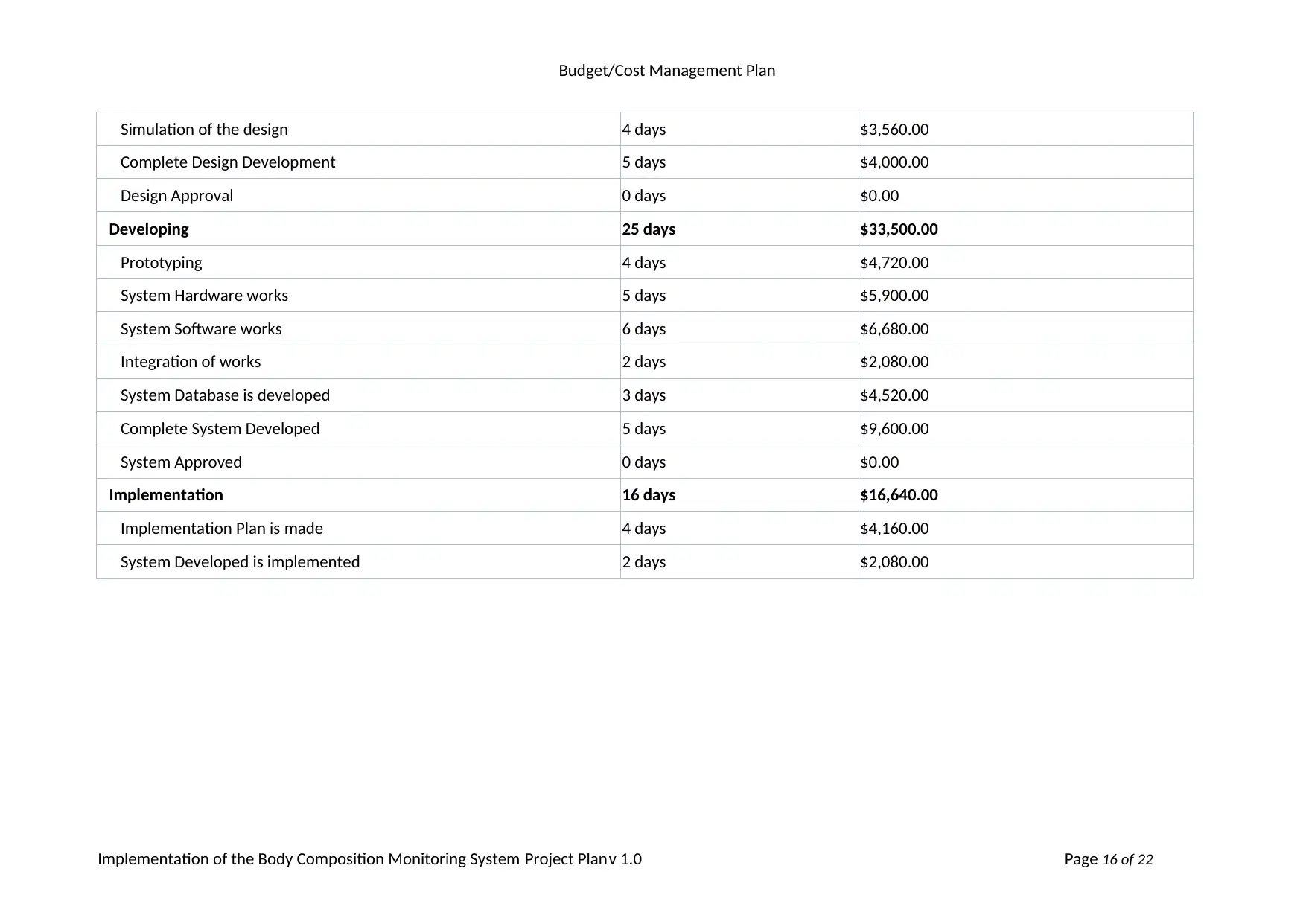
Budget/Cost Management Plan
Simulation of the design 4 days $3,560.00
Complete Design Development 5 days $4,000.00
Design Approval 0 days $0.00
Developing 25 days $33,500.00
Prototyping 4 days $4,720.00
System Hardware works 5 days $5,900.00
System Software works 6 days $6,680.00
Integration of works 2 days $2,080.00
System Database is developed 3 days $4,520.00
Complete System Developed 5 days $9,600.00
System Approved 0 days $0.00
Implementation 16 days $16,640.00
Implementation Plan is made 4 days $4,160.00
System Developed is implemented 2 days $2,080.00
Implementation of the Body Composition Monitoring System Project Planv 1.0 Page 16 of 22
Simulation of the design 4 days $3,560.00
Complete Design Development 5 days $4,000.00
Design Approval 0 days $0.00
Developing 25 days $33,500.00
Prototyping 4 days $4,720.00
System Hardware works 5 days $5,900.00
System Software works 6 days $6,680.00
Integration of works 2 days $2,080.00
System Database is developed 3 days $4,520.00
Complete System Developed 5 days $9,600.00
System Approved 0 days $0.00
Implementation 16 days $16,640.00
Implementation Plan is made 4 days $4,160.00
System Developed is implemented 2 days $2,080.00
Implementation of the Body Composition Monitoring System Project Planv 1.0 Page 16 of 22
Secure Best Marks with AI Grader
Need help grading? Try our AI Grader for instant feedback on your assignments.
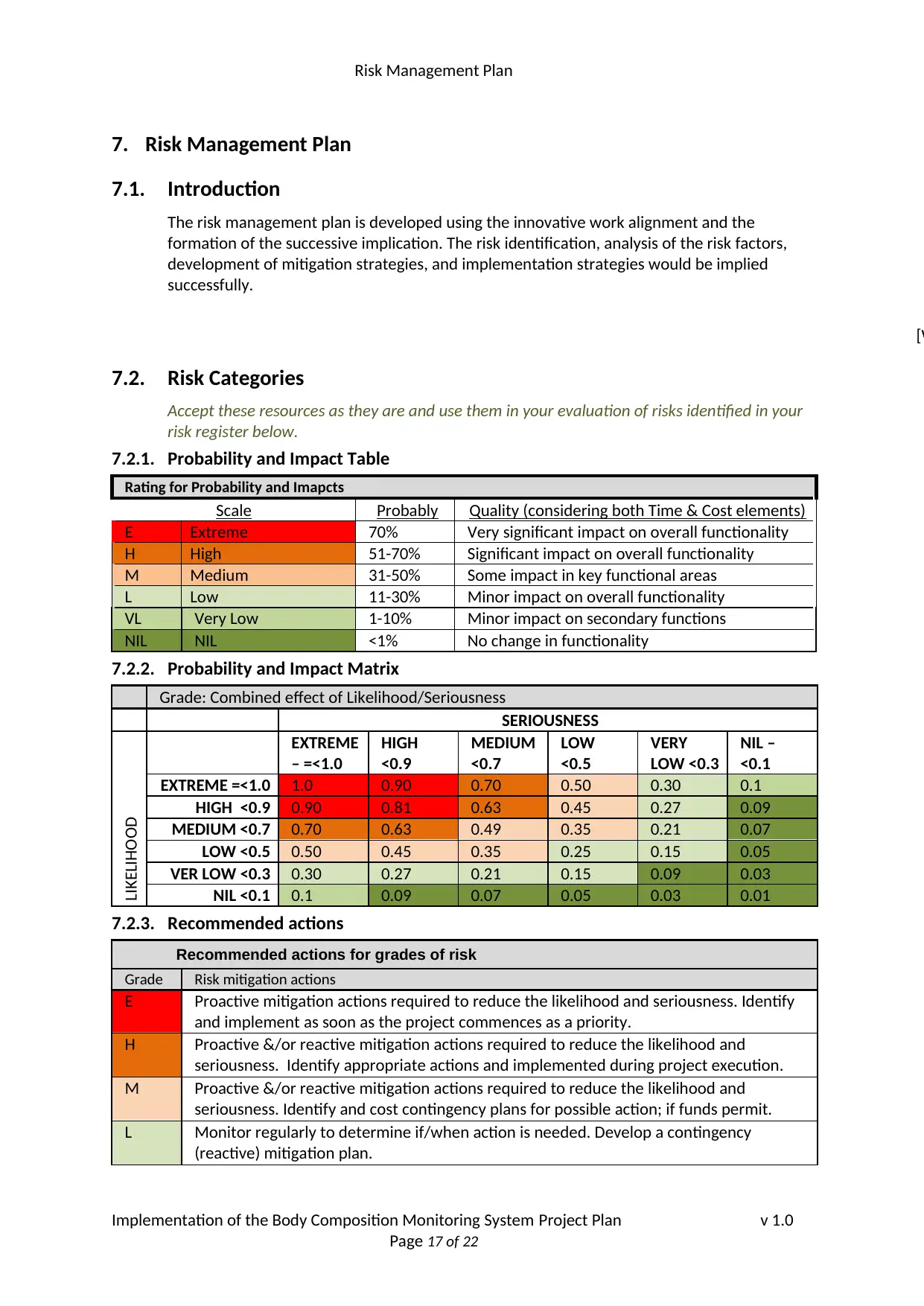
Risk Management Plan
7. Risk Management Plan
7.1. Introduction
The risk management plan is developed using the innovative work alignment and the
formation of the successive implication. The risk identification, analysis of the risk factors,
development of mitigation strategies, and implementation strategies would be implied
successfully.
[W
7.2. Risk Categories
Accept these resources as they are and use them in your evaluation of risks identified in your
risk register below.
7.2.1. Probability and Impact Table
Rating for Probability and Imapcts
Scale Probably Quality (considering both Time & Cost elements)
E Extreme 70% Very significant impact on overall functionality
H High 51-70% Significant impact on overall functionality
M Medium 31-50% Some impact in key functional areas
L Low 11-30% Minor impact on overall functionality
VL Very Low 1-10% Minor impact on secondary functions
NIL NIL <1% No change in functionality
7.2.2. Probability and Impact Matrix
Grade: Combined effect of Likelihood/Seriousness
SERIOUSNESS
LIKELIHOOD
EXTREME
– =<1.0
HIGH
<0.9
MEDIUM
<0.7
LOW
<0.5
VERY
LOW <0.3
NIL –
<0.1
EXTREME =<1.0 1.0 0.90 0.70 0.50 0.30 0.1
HIGH <0.9 0.90 0.81 0.63 0.45 0.27 0.09
MEDIUM <0.7 0.70 0.63 0.49 0.35 0.21 0.07
LOW <0.5 0.50 0.45 0.35 0.25 0.15 0.05
VER LOW <0.3 0.30 0.27 0.21 0.15 0.09 0.03
NIL <0.1 0.1 0.09 0.07 0.05 0.03 0.01
7.2.3. Recommended actions
Recommended actions for grades of risk
Grade Risk mitigation actions
E Proactive mitigation actions required to reduce the likelihood and seriousness. Identify
and implement as soon as the project commences as a priority.
H Proactive &/or reactive mitigation actions required to reduce the likelihood and
seriousness. Identify appropriate actions and implemented during project execution.
M Proactive &/or reactive mitigation actions required to reduce the likelihood and
seriousness. Identify and cost contingency plans for possible action; if funds permit.
Monitor regularly.L Monitor regularly to determine if/when action is needed. Develop a contingency
(reactive) mitigation plan.
Implementation of the Body Composition Monitoring System Project Plan v 1.0
Page 17 of 22
7. Risk Management Plan
7.1. Introduction
The risk management plan is developed using the innovative work alignment and the
formation of the successive implication. The risk identification, analysis of the risk factors,
development of mitigation strategies, and implementation strategies would be implied
successfully.
[W
7.2. Risk Categories
Accept these resources as they are and use them in your evaluation of risks identified in your
risk register below.
7.2.1. Probability and Impact Table
Rating for Probability and Imapcts
Scale Probably Quality (considering both Time & Cost elements)
E Extreme 70% Very significant impact on overall functionality
H High 51-70% Significant impact on overall functionality
M Medium 31-50% Some impact in key functional areas
L Low 11-30% Minor impact on overall functionality
VL Very Low 1-10% Minor impact on secondary functions
NIL NIL <1% No change in functionality
7.2.2. Probability and Impact Matrix
Grade: Combined effect of Likelihood/Seriousness
SERIOUSNESS
LIKELIHOOD
EXTREME
– =<1.0
HIGH
<0.9
MEDIUM
<0.7
LOW
<0.5
VERY
LOW <0.3
NIL –
<0.1
EXTREME =<1.0 1.0 0.90 0.70 0.50 0.30 0.1
HIGH <0.9 0.90 0.81 0.63 0.45 0.27 0.09
MEDIUM <0.7 0.70 0.63 0.49 0.35 0.21 0.07
LOW <0.5 0.50 0.45 0.35 0.25 0.15 0.05
VER LOW <0.3 0.30 0.27 0.21 0.15 0.09 0.03
NIL <0.1 0.1 0.09 0.07 0.05 0.03 0.01
7.2.3. Recommended actions
Recommended actions for grades of risk
Grade Risk mitigation actions
E Proactive mitigation actions required to reduce the likelihood and seriousness. Identify
and implement as soon as the project commences as a priority.
H Proactive &/or reactive mitigation actions required to reduce the likelihood and
seriousness. Identify appropriate actions and implemented during project execution.
M Proactive &/or reactive mitigation actions required to reduce the likelihood and
seriousness. Identify and cost contingency plans for possible action; if funds permit.
Monitor regularly.L Monitor regularly to determine if/when action is needed. Develop a contingency
(reactive) mitigation plan.
Implementation of the Body Composition Monitoring System Project Plan v 1.0
Page 17 of 22
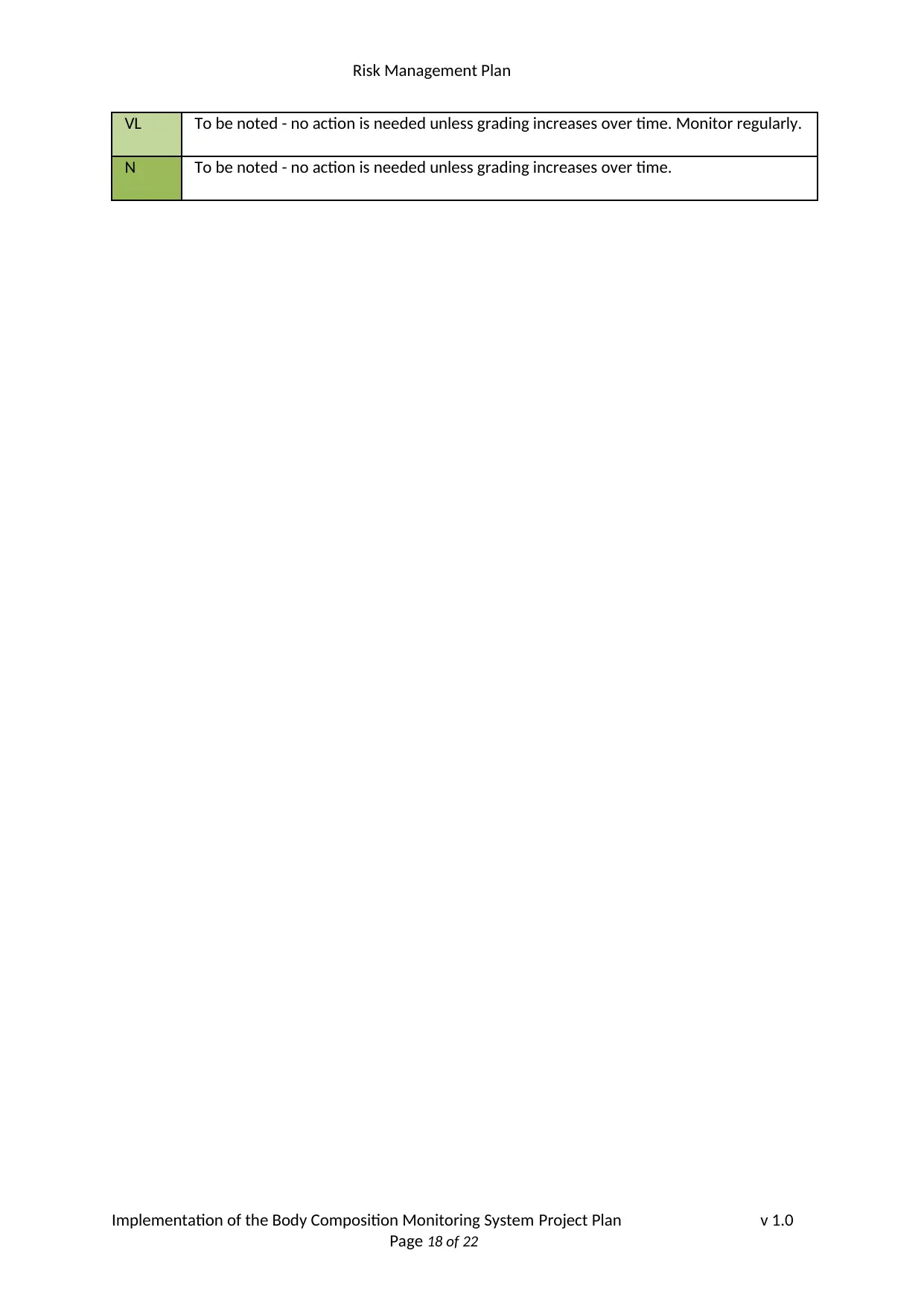
Risk Management Plan
VL To be noted - no action is needed unless grading increases over time. Monitor regularly.
N To be noted - no action is needed unless grading increases over time.
Implementation of the Body Composition Monitoring System Project Plan v 1.0
Page 18 of 22
VL To be noted - no action is needed unless grading increases over time. Monitor regularly.
N To be noted - no action is needed unless grading increases over time.
Implementation of the Body Composition Monitoring System Project Plan v 1.0
Page 18 of 22
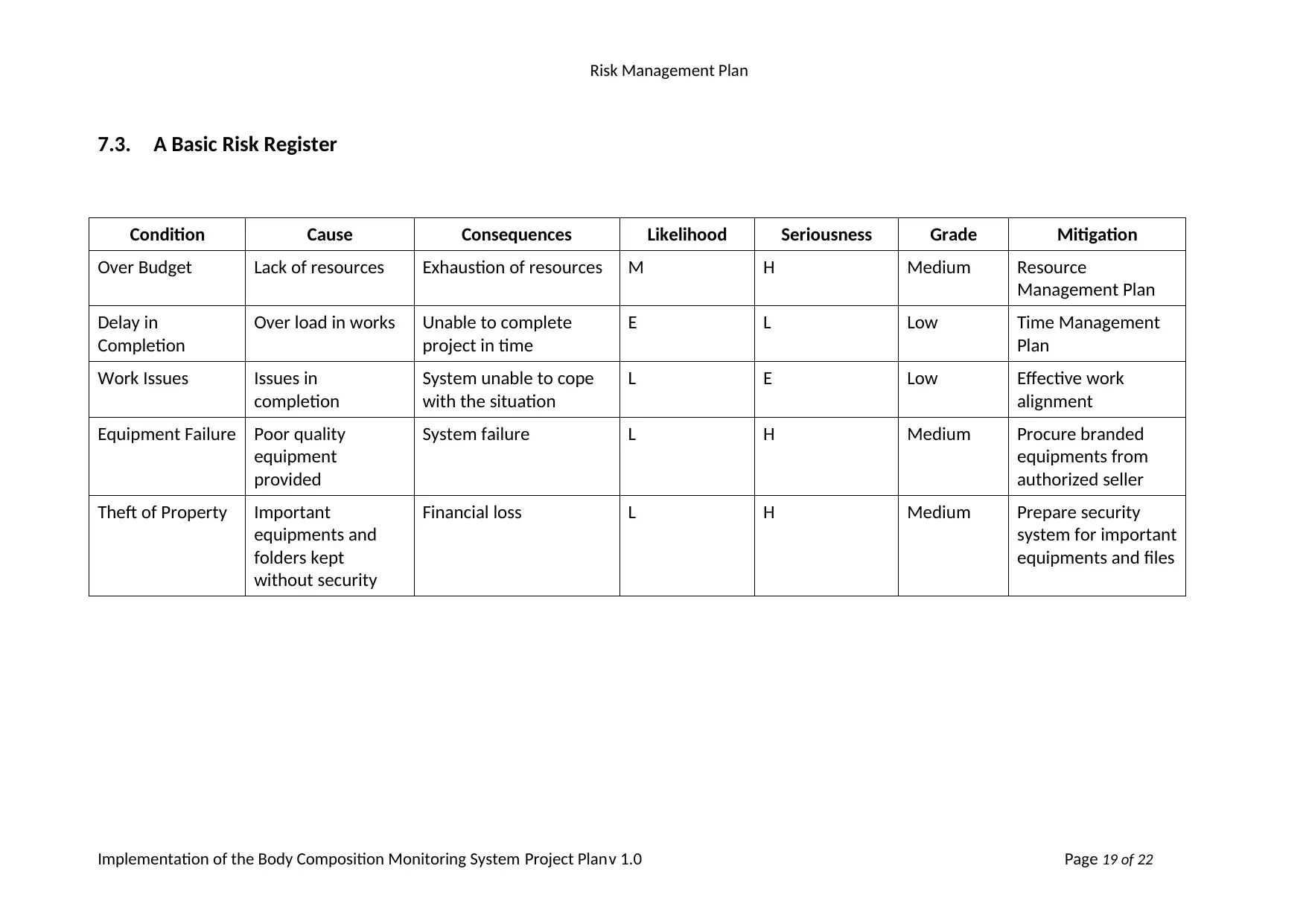
Risk Management Plan
7.3. A Basic Risk Register
Condition Cause Consequences Likelihood Seriousness Grade Mitigation
Over Budget Lack of resources Exhaustion of resources M H Medium Resource
Management Plan
Delay in
Completion
Over load in works Unable to complete
project in time
E L Low Time Management
Plan
Work Issues Issues in
completion
System unable to cope
with the situation
L E Low Effective work
alignment
Equipment Failure Poor quality
equipment
provided
System failure L H Medium Procure branded
equipments from
authorized seller
Theft of Property Important
equipments and
folders kept
without security
Financial loss L H Medium Prepare security
system for important
equipments and files
Implementation of the Body Composition Monitoring System Project Planv 1.0 Page 19 of 22
7.3. A Basic Risk Register
Condition Cause Consequences Likelihood Seriousness Grade Mitigation
Over Budget Lack of resources Exhaustion of resources M H Medium Resource
Management Plan
Delay in
Completion
Over load in works Unable to complete
project in time
E L Low Time Management
Plan
Work Issues Issues in
completion
System unable to cope
with the situation
L E Low Effective work
alignment
Equipment Failure Poor quality
equipment
provided
System failure L H Medium Procure branded
equipments from
authorized seller
Theft of Property Important
equipments and
folders kept
without security
Financial loss L H Medium Prepare security
system for important
equipments and files
Implementation of the Body Composition Monitoring System Project Planv 1.0 Page 19 of 22
Paraphrase This Document
Need a fresh take? Get an instant paraphrase of this document with our AI Paraphraser
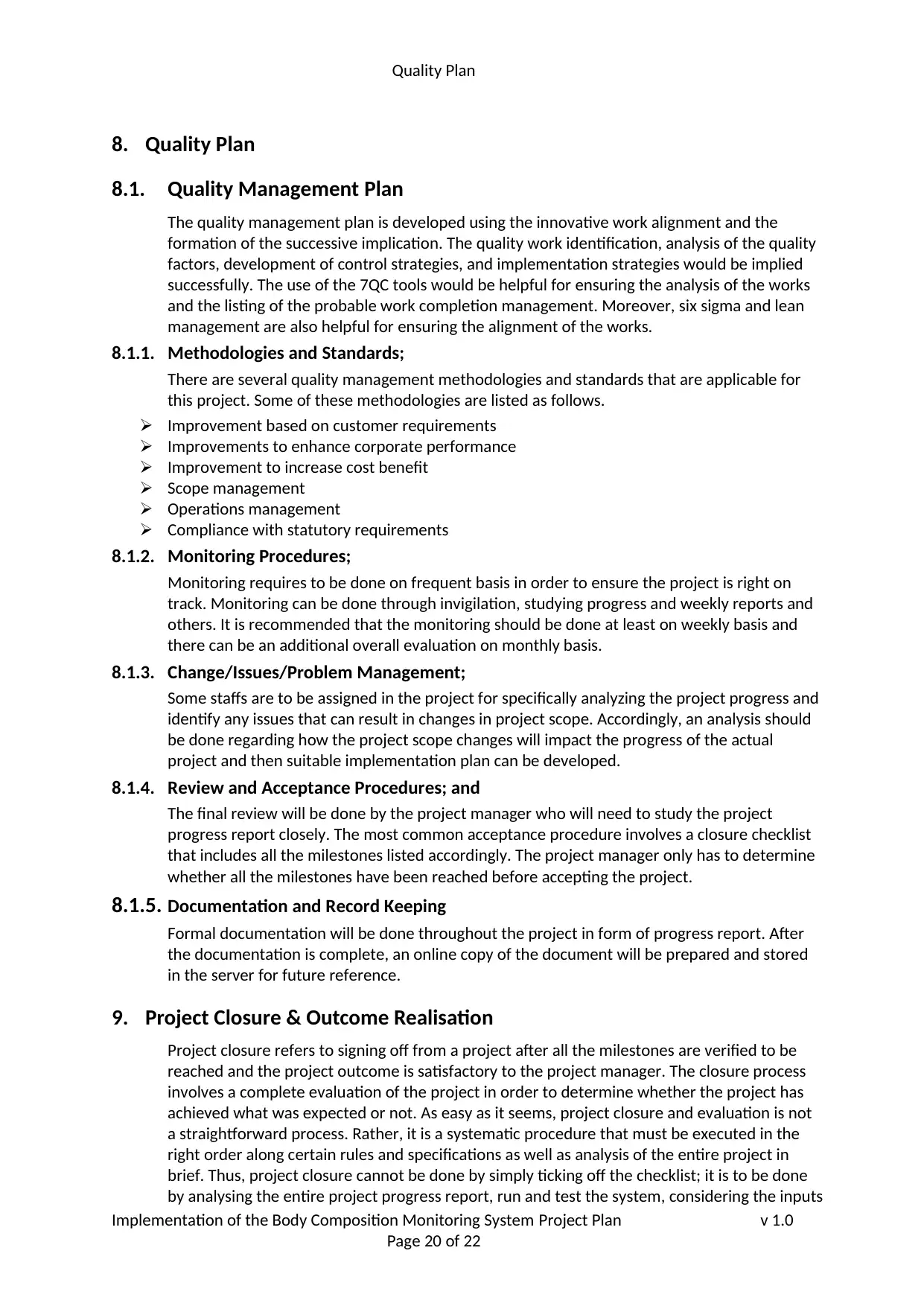
Quality Plan
8. Quality Plan
8.1. Quality Management Plan
The quality management plan is developed using the innovative work alignment and the
formation of the successive implication. The quality work identification, analysis of the quality
factors, development of control strategies, and implementation strategies would be implied
successfully. The use of the 7QC tools would be helpful for ensuring the analysis of the works
and the listing of the probable work completion management. Moreover, six sigma and lean
management are also helpful for ensuring the alignment of the works.
8.1.1. Methodologies and Standards;
There are several quality management methodologies and standards that are applicable for
this project. Some of these methodologies are listed as follows.
Improvement based on customer requirements
Improvements to enhance corporate performance
Improvement to increase cost benefit
Scope management
Operations management
Compliance with statutory requirements
8.1.2. Monitoring Procedures;
Monitoring requires to be done on frequent basis in order to ensure the project is right on
track. Monitoring can be done through invigilation, studying progress and weekly reports and
others. It is recommended that the monitoring should be done at least on weekly basis and
there can be an additional overall evaluation on monthly basis.
8.1.3. Change/Issues/Problem Management;
Some staffs are to be assigned in the project for specifically analyzing the project progress and
identify any issues that can result in changes in project scope. Accordingly, an analysis should
be done regarding how the project scope changes will impact the progress of the actual
project and then suitable implementation plan can be developed.
8.1.4. Review and Acceptance Procedures; and
The final review will be done by the project manager who will need to study the project
progress report closely. The most common acceptance procedure involves a closure checklist
that includes all the milestones listed accordingly. The project manager only has to determine
whether all the milestones have been reached before accepting the project.
8.1.5. Documentation and Record Keeping
Formal documentation will be done throughout the project in form of progress report. After
the documentation is complete, an online copy of the document will be prepared and stored
in the server for future reference.
9. Project Closure & Outcome Realisation
Project closure refers to signing off from a project after all the milestones are verified to be
reached and the project outcome is satisfactory to the project manager. The closure process
involves a complete evaluation of the project in order to determine whether the project has
achieved what was expected or not. As easy as it seems, project closure and evaluation is not
a straightforward process. Rather, it is a systematic procedure that must be executed in the
right order along certain rules and specifications as well as analysis of the entire project in
brief. Thus, project closure cannot be done by simply ticking off the checklist; it is to be done
by analysing the entire project progress report, run and test the system, considering the inputs
Implementation of the Body Composition Monitoring System Project Plan v 1.0
Page 20 of 22
8. Quality Plan
8.1. Quality Management Plan
The quality management plan is developed using the innovative work alignment and the
formation of the successive implication. The quality work identification, analysis of the quality
factors, development of control strategies, and implementation strategies would be implied
successfully. The use of the 7QC tools would be helpful for ensuring the analysis of the works
and the listing of the probable work completion management. Moreover, six sigma and lean
management are also helpful for ensuring the alignment of the works.
8.1.1. Methodologies and Standards;
There are several quality management methodologies and standards that are applicable for
this project. Some of these methodologies are listed as follows.
Improvement based on customer requirements
Improvements to enhance corporate performance
Improvement to increase cost benefit
Scope management
Operations management
Compliance with statutory requirements
8.1.2. Monitoring Procedures;
Monitoring requires to be done on frequent basis in order to ensure the project is right on
track. Monitoring can be done through invigilation, studying progress and weekly reports and
others. It is recommended that the monitoring should be done at least on weekly basis and
there can be an additional overall evaluation on monthly basis.
8.1.3. Change/Issues/Problem Management;
Some staffs are to be assigned in the project for specifically analyzing the project progress and
identify any issues that can result in changes in project scope. Accordingly, an analysis should
be done regarding how the project scope changes will impact the progress of the actual
project and then suitable implementation plan can be developed.
8.1.4. Review and Acceptance Procedures; and
The final review will be done by the project manager who will need to study the project
progress report closely. The most common acceptance procedure involves a closure checklist
that includes all the milestones listed accordingly. The project manager only has to determine
whether all the milestones have been reached before accepting the project.
8.1.5. Documentation and Record Keeping
Formal documentation will be done throughout the project in form of progress report. After
the documentation is complete, an online copy of the document will be prepared and stored
in the server for future reference.
9. Project Closure & Outcome Realisation
Project closure refers to signing off from a project after all the milestones are verified to be
reached and the project outcome is satisfactory to the project manager. The closure process
involves a complete evaluation of the project in order to determine whether the project has
achieved what was expected or not. As easy as it seems, project closure and evaluation is not
a straightforward process. Rather, it is a systematic procedure that must be executed in the
right order along certain rules and specifications as well as analysis of the entire project in
brief. Thus, project closure cannot be done by simply ticking off the checklist; it is to be done
by analysing the entire project progress report, run and test the system, considering the inputs
Implementation of the Body Composition Monitoring System Project Plan v 1.0
Page 20 of 22
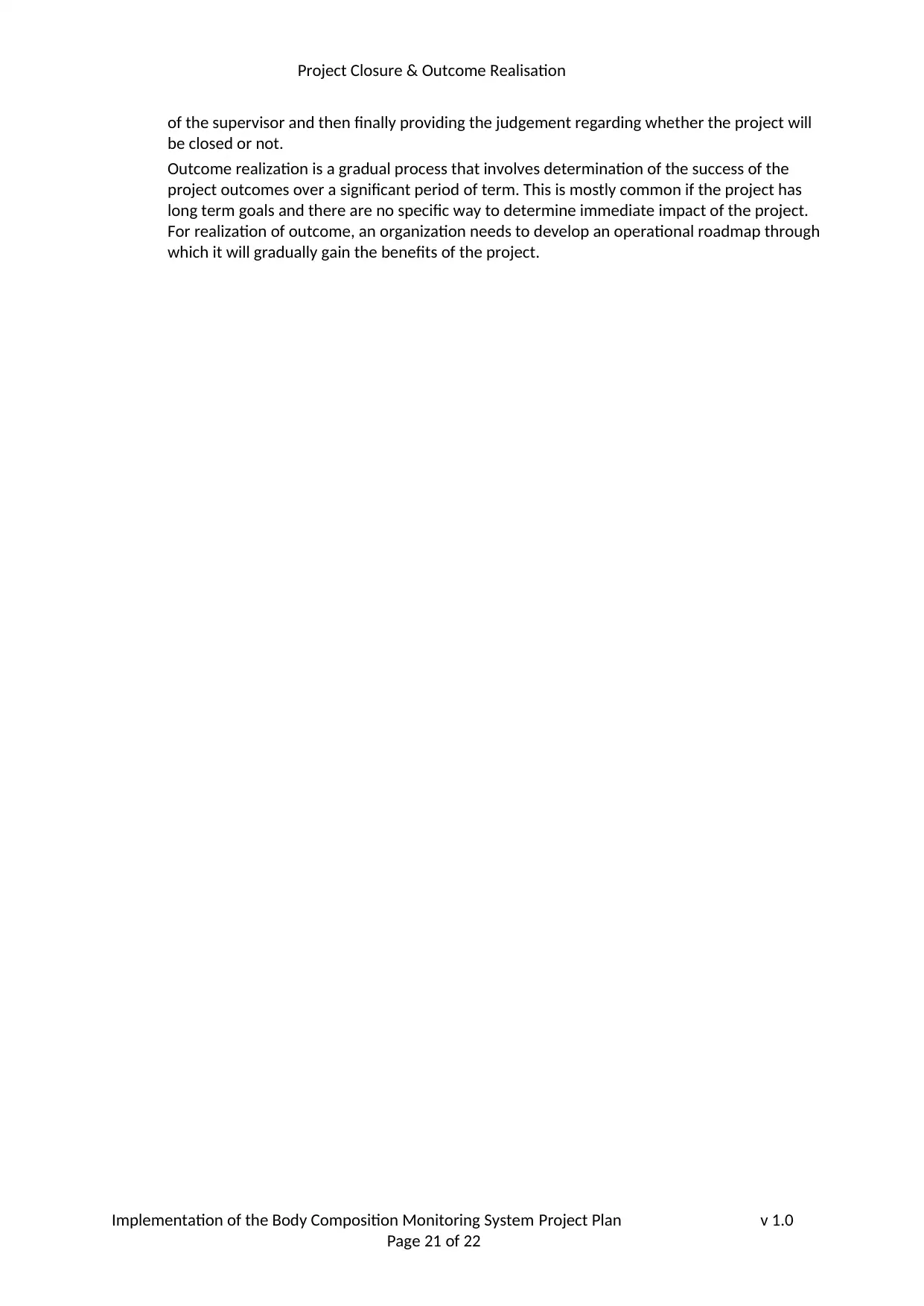
Project Closure & Outcome Realisation
of the supervisor and then finally providing the judgement regarding whether the project will
be closed or not.
Outcome realization is a gradual process that involves determination of the success of the
project outcomes over a significant period of term. This is mostly common if the project has
long term goals and there are no specific way to determine immediate impact of the project.
For realization of outcome, an organization needs to develop an operational roadmap through
which it will gradually gain the benefits of the project.
Implementation of the Body Composition Monitoring System Project Plan v 1.0
Page 21 of 22
of the supervisor and then finally providing the judgement regarding whether the project will
be closed or not.
Outcome realization is a gradual process that involves determination of the success of the
project outcomes over a significant period of term. This is mostly common if the project has
long term goals and there are no specific way to determine immediate impact of the project.
For realization of outcome, an organization needs to develop an operational roadmap through
which it will gradually gain the benefits of the project.
Implementation of the Body Composition Monitoring System Project Plan v 1.0
Page 21 of 22
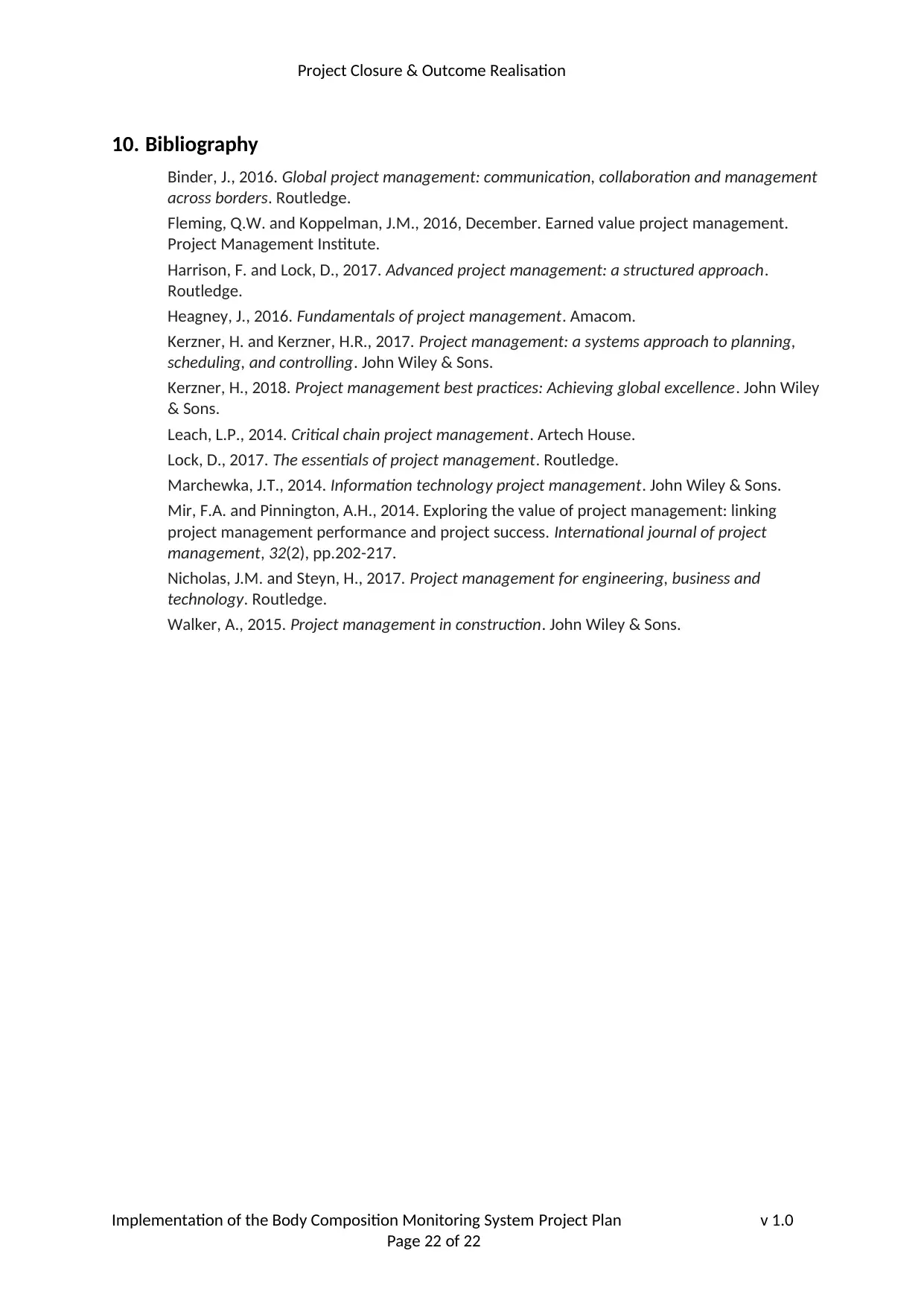
Project Closure & Outcome Realisation
10. Bibliography
Binder, J., 2016. Global project management: communication, collaboration and management
across borders. Routledge.
Fleming, Q.W. and Koppelman, J.M., 2016, December. Earned value project management.
Project Management Institute.
Harrison, F. and Lock, D., 2017. Advanced project management: a structured approach.
Routledge.
Heagney, J., 2016. Fundamentals of project management. Amacom.
Kerzner, H. and Kerzner, H.R., 2017. Project management: a systems approach to planning,
scheduling, and controlling. John Wiley & Sons.
Kerzner, H., 2018. Project management best practices: Achieving global excellence. John Wiley
& Sons.
Leach, L.P., 2014. Critical chain project management. Artech House.
Lock, D., 2017. The essentials of project management. Routledge.
Marchewka, J.T., 2014. Information technology project management. John Wiley & Sons.
Mir, F.A. and Pinnington, A.H., 2014. Exploring the value of project management: linking
project management performance and project success. International journal of project
management, 32(2), pp.202-217.
Nicholas, J.M. and Steyn, H., 2017. Project management for engineering, business and
technology. Routledge.
Walker, A., 2015. Project management in construction. John Wiley & Sons.
Implementation of the Body Composition Monitoring System Project Plan v 1.0
Page 22 of 22
10. Bibliography
Binder, J., 2016. Global project management: communication, collaboration and management
across borders. Routledge.
Fleming, Q.W. and Koppelman, J.M., 2016, December. Earned value project management.
Project Management Institute.
Harrison, F. and Lock, D., 2017. Advanced project management: a structured approach.
Routledge.
Heagney, J., 2016. Fundamentals of project management. Amacom.
Kerzner, H. and Kerzner, H.R., 2017. Project management: a systems approach to planning,
scheduling, and controlling. John Wiley & Sons.
Kerzner, H., 2018. Project management best practices: Achieving global excellence. John Wiley
& Sons.
Leach, L.P., 2014. Critical chain project management. Artech House.
Lock, D., 2017. The essentials of project management. Routledge.
Marchewka, J.T., 2014. Information technology project management. John Wiley & Sons.
Mir, F.A. and Pinnington, A.H., 2014. Exploring the value of project management: linking
project management performance and project success. International journal of project
management, 32(2), pp.202-217.
Nicholas, J.M. and Steyn, H., 2017. Project management for engineering, business and
technology. Routledge.
Walker, A., 2015. Project management in construction. John Wiley & Sons.
Implementation of the Body Composition Monitoring System Project Plan v 1.0
Page 22 of 22
1 out of 22
Related Documents
Your All-in-One AI-Powered Toolkit for Academic Success.
+13062052269
info@desklib.com
Available 24*7 on WhatsApp / Email
![[object Object]](/_next/static/media/star-bottom.7253800d.svg)
Unlock your academic potential
© 2024 | Zucol Services PVT LTD | All rights reserved.




